Fine and Rare Books



Buddenbrooks has one of the finest selections of fine and rare books in a number of fields, but we are happy to find any books, old or new, for our customers. If there is something you can't find in your hometown, or if you prefer to shop by mail, let us know and we will be happy to take care of your order. Buddenbrooks offers shipping to almost any place on this planet.
*Prices are net; postage and insurance are extra.
*All books are offered subject to prior sale.
*Bookplates and previous owners’ signatures are not noted unless particularly obtrusive.
*We respectfully request that payment be included with orders.
*Massachusetts residents are requested to include 6.25% sales tax.
*All books are returnable within ten days. We ask that you notify us by phone or email in advance if you are returning a book.
*We offer deferred billing to institutions in order to accommodate budgetary requirements.
*Prices are subject to change without notice and we cannot be responsible for misprints or typographical errors.
Desiderata Invited...Out-of-print Searches...Appraisals
We are always interested in purchasing fine books, either single volumes or libraries.
The First Edition of Sonnets From the Portuguese A Handsome and Pleasing Set - Elizabeth Barrett Browning Two Volumes - 1850 - In Rare Contemporary Bindings Gilt
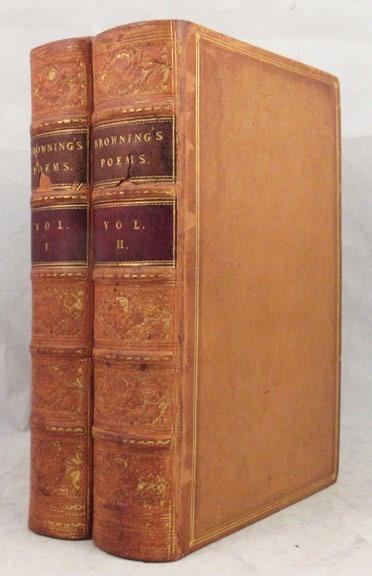
11 Browning, Elizabeth Barrett. [SONNETS FROM THE PORTUGUESE] POEMS (London: Chapman & Hall, 1850) 2 volumes. New Edition. The FIRST EDITION of SONNETS FROM THE PORTUGUESE. 8vo, handsomely bound in contemporary polished calf, the spines with raised bands gilt tooled, the compartments of the spines with richly gilt panels incorporating floral tools at their centers, two compartments with contrasting brown and maroon lettering labels gilt, board edges gilt tooled, tunovers fully roll tooled in gilt, marbled endleaves, all edges gilt. xii, 362, [1];viii, 480 pp. A handsome and pleasing and honest set in rare period binding, showing the small blind stamp to the verso of the front marbled free-fly of each volume, by Simms & Dinham Booksellers who were active in Manchester, England during the 1840’s and 1850’s. The calf bindings strong and very well preserved, slight rubbing to the extremities, the spines with light rubbing to the gilt from handling, one label slightly chipped, the other a touch rubbed at the base. The books are clean throughout with none of the foxing that is often present.
RARE IN THIS CONDITION AND THE FIRST EDITION OF SONNETS FROM THE PORTUGUESE, ELIZABETH BARRETT BROWNING’S MOST CELEBRATED POETRY. VERY UNCOMMON AND ELUSIVE. Barrett Browning was initially hesitant to publish the poems, believing they were too personal. However, her husband Robert Browning insisted they were the best sequence of English-language sonnets since Shakespeare’s time and urged her to publish them. To offer the couple some privacy, she decided to publish them as if they were translations of foreign sonnets. She initially planned to title the collection “Sonnets translated from the Bosnian”, but Browning proposed that she claim their source was Portuguese, probably because of her admiration for Camões and Robert’s nickname for her: “my little Portuguese”. The title is also a reference to Les Lettres Portugaises (1689).
Her 1844 volume Poems had made her one of the most popular writers in the country, and inspired Robert Browning to write to her. He wrote, “I love your verses with all my heart, dear Miss Barrett,” praising their “fresh strange music, the affluent language, the exquisite pathos and true new brave thought.”
John Kenyon, a wealthy friend of the family and patron of the arts, arranged for Browning to meet Elizabeth on 20 May 1845 in her rooms, and so began one of the most famous courtships in literature. Elizabeth had already produced a large amount of work, but Browning had a great influence on her subsequent writing, as did she on his: two of Barrett’s most famous pieces were written after she met Browning, Sonnets from the Portuguese and Aurora Leigh. Robert’s Men and Women is also a product of that time.
Elizabeth opposed slavery and published two poems highlighting the barbarity the institution and her support for the abolitionist cause: “The Runaway Slave at Pilgrim’s Point”; and “A Curse for a Nation”. In “Runaway” she describes an enslaved woman who is whipped, raped, and made pregnant as she curses her enslavers.
Browning’s poetry was critically and publicly acclaimed while she was alive; she was considered Wordsworth’s successor as Poet Laureate upon his death. However, Browning’s very advanced ideas will appeal to readers of this generation. Browning was sympathetic to the ideas of Mary Wollstonecraft, politically progressive in her views and in the literary realm, transformed poetic style and content. Thus, her work is by no means a mere curiosity but rather representative of the highest literary and intellectual achievements.
Two of her most famous poems, from SONNETS FROM THE PORTUGUESE:
Number 43
How do I love thee? Let me count the ways. I love thee to the depth and breadth and height My soul can reach, when feeling out of sight For the ends of Being and Ideal Grace. I love thee to the level of everyday’s Most quiet need, by sun and candlelight. I love thee freely, as men strive for Right; I love thee purely, as they turn from Praise; I love thee with the passion put to use In my old griefs, and with my childhood’s faith; I love thee with a love I seemed to lose With my lost saints,—I love thee with the breath, Smiles, tears, of all my life!—and, if God choose, I shall but love thee better after death.
Number 33
Yes, call me by my pet-name! let me hear The name I used to run at, when a child, From innocent play, and leave the cowslips piled, To glance up in some face that proved me dear With the look of its eyes. I miss the clear Fond voices, which, being drawn and reconciled Into the music of Heaven’s undefiled, Call me no longer. Silence on the bier, While I call God...call God!—So let thy mouth Be heir to those who are now exanimate: Gather the north flowers to complete the south, And catch the early love up in the late! Yes, call me by that name,—and I, in truth, With the same heart, will answer, and not wait $8500.
The Works of Lord Byron - Printed by Didot - 1826

In a Superb Binding by Jean-Georges Purgold of Paris
With the Letter Denying Authorship of “The Vampyre”
12 Byron, [George Gordon] Lord. THE WORKS OF LORD BYRON Including the Suppressed Poems. Complete in One Volume. (Paris: Printed by Jules Didot, Senior, Published by A. and W. Galignani and bound by JeanGeorges Purgold, 1826) Early Issue of the Complete Collection of Byron’s Works, a First Edition Thus. Very rare issue with the portrait frontispieces in two states, one proof and one finished as issued, and with the rare and famous letter of Byron’s denying the authorship of “The Vampyre”. Quarto, offered in a superb binding executed and signed by the great binder Jean-Georges Purgold of Paris of full red straight grain morocco, the spine with four wide raised bands gilt ruled separating the compartments, four compartments richly gilt with full panels incorporating elegant floral corner tools surrounding a multi-ruled diamond pattern gilt, enclosing a central diamond and floral tooled element in blind, two compartments ruled in gilt, the covers with elaborate multi-ruled borders gilt, enclosing inner elaborate borders tooled in blind and a central multi-ruled vertically centered diamond beautifully tooled in gilt and blind, the inner borders with elaborate and large floral corner pieces joining the gilt rules. edges triple gilt ruled, turnovers multi-gilt ruled with floral corner pieces, marbled
endleaves, all edges gilt.
‘Purgold (1784 - Paris, March 7, 1829), originally from Darmstadt is ranked as one of the greatest bookbinders of the 19th century, along with René Simier and Joseph Thouveninof. He was dubbed “The Meticulous.” Ramsden considered him to be the best binder of the group, especially when it came to precision. Culot calls him the “master of fillets”. This is certainly the case with the binding presented here which includes 21 executed fillets to each cover, in addition to those adorning each raised band and panel. xliii, [1], 715 A very handsome copy indeed, printed beautifully by Didot and bound luxuriously by Purgold, the book remains very well preserved with very minor evidence of age, the text-block clean and generally bright with occasional notes of mellowing or spotting though far less than is normal to the printing, the binding tight and sound, the hinges in excellent order. A lovely copy of an important book.
FIRST EDITION THUS AND A VERY EARLY ISSUE OF BYRON’S COMPLETE WORKS ISSUED JUST TWO YEARS AFTER HIS DEATH, PRESENTED IN A LUXURIOUS BINDING BY PURGOLD. Lord Byron was one of the leading figures of the Romantic Movement and remains today one of the most popular and romantic poets of the language. Often described as the most flamboyant and notorious of the major Romantics, Byron was both celebrated and castigated in life for his aristocratic excesses, including huge debts and numerous love affairs. He has since become regarded as one of the greatest British poets, and remains widely read and influential. Among Byron’s best-known works are the narrative poems Don Juan and Childe Harold’s Pilgrimage and the short lyric She Walks in Beauty.
‘Jean-Georges Purgold was first apprenticed to the great bookbinder Jean-Claude Bozerian, then founded his workshop after the latter’s retirement in 1810. He settled in rue Dauphine, then rue Cassette in Paris. During the Restoration, the workshop already had a reputation for seriousness and quality. Lesné, bookbinder and contemporary poet of this generation, describes him as “prince of bookbinders”.
Like all his generation, Purgold began by copying “Bozerian” binding before deviating from it, experimenting with often complex ornamentation, executed with iron, sometimes with a plate in the center of the covers. At the end of his activity, in 1828-1829, he even executed “cathedral” bindings in the style of the time.

From 1820, Purgold received as a gilder worker in his workshop Antoine Bauzonnet, then 25 years old and already solidly trained by ten years of apprenticeship in the Jura. Between 1820 and 1825 Purgold partnered with an English bookbinder named Hering, but the partnership did not last.
Purgold died in March 1829, leaving a workshop in full glory to his widow, who continued the activity, as well as to his workman who had recently become his new partner, Antoine Bauzonnet. Thanks to the latter, then to Georges Trautz, husband of Alexandrine Estelle Elisabeth Purgold, the workshop founded in 1810 lasted until the Third Republic.’
A fine “Life of Lord Byron” by J.W. Lake precedes the Works and is complete unto itself. Lake’s biography of Byron was published by Galignani in the same year as this volume.
Didot is the name of a family of French printers, punch-cutters and publishers. Through its achievements and advancements in printing, publishing and typography, the family has lent its name to typographic measurements developed by FrançoisAmbroise Didot and the Didot typeface developed by Firmin Didot. Jules Didot (son of Pierre Didot) was born in 1794 and died in 1871. Jules Didot is famous for his invention of round-edged initials, to take the place of the sharp-edged ones. In 1825 he took his printing plant to Brussels and founded the Royal Printing House. Pierre Didot was awarded a gold medal at the exhibition of 1798, for his edition of Virgil. By order of the Government, his presses were established in the Louvre, where they remained during the Consulate. The celebrated Louvre editions are Virgil (1798), Horace (1799), Racine (1801–5), La Fontaine (1802), and Boileau (1816). The board of examiners of the 1806 exhibition pronounced the Racine edition “the most perfect typographical production of all ages”.Along with Giambattista Bodoni of Italy, Firmin Didot is
credited with designing and establishing the use of the “Modern” classification of typefaces. The types that Didot used are characterized by extreme contrast in thick strokes and thin strokes, by the use of hairline serifs and by the vertical stress of the letters. Many fonts today are available based on Firmin Didot’s typefaces. Wikipédia (French $2750.
Sartor Resartus - A Brilliantly Humourous Novel Thomas Carlyle’s First Major Work - 1838 Influential for Emerson and the Transcendentalists
13 Carlyle, Thomas. SARTOR RESARTUS: THE LIFE AND OPINIONS OF HERR TEUFELSDROECKH (London: Saunders and Otley, 1838) First English edition. The copy of Graham Pollard, British bibliophile, bookseller and London Bibliographical Society President and Gold Medal winner. With his handsome engraved bookplate. 8vo, contemporary three-quarter green calf over green cloth-covered boards, the spine with gilt hatched raised bands, blind ruled compartments with central blind tool, one compartment with a red morocco label gilt ruled and lettered. Bound without half-title. xii, 310pp. A very handsome copy, the contemporary calf is attractive and well preserved, a little wear on the corner-pieces, the cloth a bit age mellowed and with one small abrasion. The text is firm and tight, a bit of very light spotting and staining to the first 12 leaves and otherwise surprisingly clean and fresh.
FIRST ENGLISH EDITION OF CARLYLE’S FIRST MAJOR WORK, A BRILLIANTLY HUMOROUS PHILOSOPHICAL NOVEL IN THE FORM OF AN ESSAY. SARTOR RESARTUS (The Tailor Re-tailored) is ostensibly a learned German treatise on the philosophy, the symbolism, and the influence of clothes; being mulled-over by a somewhat skeptical and cantankerous English editor and reviewer. The main theme, that the intellectual forms in which the deepest human convictions have been cast are dead and new ones must be found to fit the time, was especially appealing to the budding Transcendentalists in New England. After its initial serial appearance in Fraser’s Magazine the first printing in book form was published in Boston with a preface by none other than Ralph Waldo Emerson. SARTOR RESARTUS was influential to the further development of that movement and the Boston edition is now rare. $950.
The True First Edition of “Alice In Wonderland”
In Contemporary Binding- The Earliest Obtainable Printing

1865 Sheets Issued With the Appleton Title-Page
14 Carroll, Lewis. ALICE’S ADVENTURES IN WONDERLAND (New York: D. Appleton & Co., 1866) First Edition, the first published edition of “Alice” comprising the original first issue sheets of the suppressed 1865 printing of Alice done in London. The sheets were sold to Appleton in New York and printed with the titlepage dated 1866 and showing New York as the place of publication. With 42 illustrations by John Tenniel. 8vo, bound in contemporary three-quarter red morocco over marbled paper covered boards, marbled endleaves, now housed in a fine morocco backed foldover case, the spine panel with raised bands, the compartments lettered in gilt. [x], 192 pp. With the half-title as called for. A very good and handsome copy, the text-block clean, the binding with bit of restoration very skillfully accomplished.
FIRST EDITION, FIRST PRINTING, FIRST PUBLISHED EDITION. THE EARLIEST OBTAINABLE EDITION OF “ALICE”. This is the true first printing of “Alice in Wonderland” comprising the sheets of the first edition still unbound when Lewis Carroll and Tenniel decided in July 1865 to recall the edition printed by Macmillan in London. Some of those sheets were then authorized to be sold to Appleton in New York and thus the first available copies of this iconic work bore an American title page imprint over the original English sheets.
ALICE’S ADVENTURES IN WONDERLAND has proven itself to be one of the most enduring classics of literature--for children or otherwise. It has been reprinted in innumerable formats, and its characters have been borrowed by, imitated by, and adapted for almost every media imaginable, from board games to postage stamps, from print to stage and film, and one would not be surprised to find a web page on the Internet devoted to Alice. Its importance might be gauged by the fact that it is one of only three books written for children (five, if one includes Aesop’s Fables and Froebel’s “Mutter- und KoseLeider”) included in the “Printing and the Mind of Man” exhibition.
ALICE’S ADVENTURES IN WONDERLAND and its sequel, THROUGH THE LOOKING-GLASS, are “unique among ‘juveniles’ in appealing equally if not more strongly to adults. Written by an Oxford don, a clergyman, and a professional mathematician, they abound in characters-the White Knight, the Red Queen, the Mad Hatter, Humpty Dumpty--who are a part of everybody’s mental furniture. And the philosophic profundity of scores, if not hundreds, of these characters’ observations, long household words wherever English is spoken, gains mightily from the delicious fantasy of their setting” (PMM 354). PMM 354. $10500.
First Edition - Charles Dickens - A Tale of Two Cities 1859 - First Issue in A Very Handsome Binding


Illustrated Throughout by Hablot K. Browne
15 Dickens, Charles. A TALE OF TWO CITIES (London: Chapman and Hall, 1859) First edition, First Issue with p. 213 mis-numbered 113 and signature b to the list of illustrations leaf and the required misspelling at p. 134. With 16 illustrations by H. K. Browne, including a frontispiece and vignette title page. 8vo, very handsomely bound in antique three-quarter tan calf, the covers with fine marbled paper over the boards, the spine elaborately decorated within panels gilt tooled at the borders and with central gilt ornamental pieces between raised bands, lettered in gilt on contrasting maroon and brown morocco lettering labels, l blue marbled endleaves, a.e.g. viii, list of plates, 254pp. A fine and very handsome copy indeed, the prelims with some browning from long ago.
FIRST EDITION, FIRST ISSUE. TALE OF TWO CITIES ranks amongst the most famous works in the history of literary fiction. It is one of only two works of historical fiction by Charles Dickens and stands out from most of Dickens’s other novels as the one containing the least humour. That is not surprising, as the historical context of the novel, the French Revolution and Reign of Terror, were a bit bleak to allow for the wackier characters Dickens is known for. This fact has in no way impacted the novel’s popularity, it has never been out of print and by the start of the 21th century had sold an estimated 200 million copies worldwide. $7500.
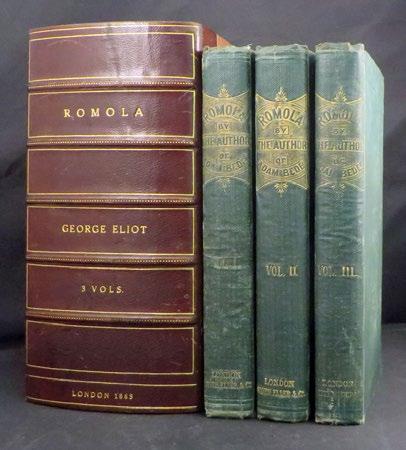
16 Eliot, George. ROMOLA (London: Smith, Elder and Co., 1863) 3 volumes. First edition. 8vo, in the original green textured cloth, quite rare thus, the boards paneled in blind, the spines gilt lettered and decorated. Housed in a single morocco backed slipcase within individual cloth-covered chemises, the morocco backed box decorated as a book with gilt tooled raised bands and gilt lettering. iv, 336; iv, 333, [2]; iv, 292 pp. A copy in original cloth and state, very rare as such, the text uncommonly fresh with only the most minor of occasional light spotting or mellowing, the cloth sturdy and dark green, a little expected rubbing and very minor edge wear, the gilt a bit dull, a few hinges with some cosmetic separation to the endpapers, the volumes still strong and tight.
VERY RARE IN ORIGINAL CLOTH AND IN SUCH ORIGINAL STATE. WE KNOW OF NO OTHER ACCEPTABLE COPY CURRENTLY ON THE MARKET IN THE ORIGINAL CLOTH. A truly outstanding copy, very desirable, this is an exceptional survival.
Eliot’s historical novel ROMOLA can be seen as a deep study of life in the city of Florence as the fictional events all take place amidst actual historical events during the Italian Renaissance, and includes in its plot several notable figures from Florentine history. Literary scholars have drawn comparisons between the setting of the novel and George Eliot’s contemporary Victorian England and the psychological and religious introspection seen in Eliot’s other novels is also seen in Romola. Sadleir 817; Wolff 2061; Parrish, p. 17; Baker & Ross A7.2. $3750.
And the First Use of Her Famous Pseudonum Scenes of a Clerical Life - Much Praised by Charles Dickens
17 Eliot, George. SCENES OF CLERICAL LIFE (Edinburgh: William Blackwood and Sons, 1858) 2 volumes. First Edition, with fine provenance having come from the collection of Robert Hoe with his gilt lettered morocco ex libris. 8vo, beautifully bound by Riviere and Son in full tan calf, the covers with multi-ruled gilt fillet lines at the borders with circular tools as corner-pieces, the spines richly gilt decorated in panels between gilt ruled and stippled raised bands, two compartments with contrasting red and green morocco labels finely gilt ruled and lettered and with gilt tooled corner-pieces, beautifully gilt tooled turn-ins and ruled board edges, marbled endpapers, t.e.g. 366; 381 pp. A superb copy and a fine and handsome set, the text clean and fresh with two edges still untrimmed and free from any spotting, the fine binding in excellent condition.
FIRST EDITION, GEORGE ELIOT’S (Mary Anne Evans) FIRST PUBLISHED FICTION AND THE FIRST WORK PUBLISHED UNDER THE GEORGE ELIOT PSEUDONYM. A collection of three short stories. Her partner, G. H. Lewes, in order to help her get her stories written and published, arranged for John Blackwood to publish these first tentative efforts claiming them to be written by a ‘friend’ named George Eliot. The stories first appeared in Blackwood’s Edinburgh Magazine throughout 1857 and were then first published in book form, as here, in January of 1858.
In this complete form it was met with ‘just and discerning applause’, and considerable speculation as to the identity of
its author. Charles Dickens, wrote to the unknown author by care of William Blackwood saying, “I have been so strongly affected by the two first tales in the book you have had the kindness to send me, through Messrs. Blackwood, that I hope you will excuse my writing to you to express my admiration of their extraordinary merit. The exquisite truth and delicacy both of the humour and the pathos of these stories, I have never seen the like of; and they have impressed me in a manner that I should find it very difficult to describe to you. if I had the impertinence to try. In addressing these few words of thankfulness to the creator of the Sad Fortunes of the Rev. Amos Barton, and the sad love-story of Mr. Gilfil, I am (I presume) bound to adopt the name that it pleases that excellent writer to assume. I can suggest no better one: but I should have been strongly disposed, if I had been left to my own devices, to address the said writer as a woman. I have observed what seemed to me such womanly touches in those moving fictions, that the assurance on the title-page is insufficient to satisfy me even now. If they originated with no woman, I believe that no man ever before had the art of making himself mentally so like a woman since the world began.” This makes him among the first to suggest the author may have actually been a woman.
Industrialist and noted book collector Robert Hoe was preeminent among American producers of printing presses. He was one of the organizers and first president of the Grolier Club, the well-known New York organization for the promotion of bookmaking as an art. His collection of rare books and manuscripts at the time of his death in 1909 was valued at several million dollars. Sadleir 818.
$3750.
The History of Tom Jones - 1749 - London
First Edition - First Issue - Contemporary Calf
18 Fielding, Henry. THE HISTORY OF TOM JONES, A FOUNDLING (London: for A. Millar, 1749) 6 volumes. First edition, the first issue with errata leaf in volume I and all the cancels listed in Rothschild (also with the cancels N12 in Vol. II and B1 in Vol. IV overlooked in the Rothschild collation). Small 8vo, handsomely bound in contemporary polished calf, the spine panels sometime replaced to match with raised bands gilt ruled, two compartments with red morocco labels gilt lettered, one compartment with date in gilt The six volumes now housed in a slipcase. lxii, errata, 214; [2], 324; [2], 370;[2], 312; [2], 294; [2], 304 pp. A handsome set, the textblocks well preserved with just a bit of expected age mellowing, the bindings handsome, one volume with some signatures springing, some expected minor rubbing at the joints and tips, one volume with a small chip.

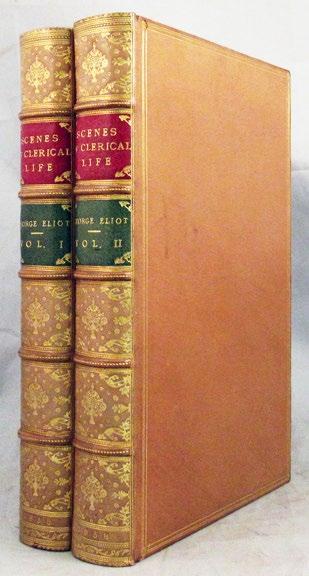
HANDSOME FIRST EDITION AND FIRST ISSUE OF A CORNERSTONE WORK IN ENGLISH LITERATURE. An attractive set of Fielding’s classic story.
‘Tom Jones’ is not only generally regarded as Fielding’s greatest work, but is one of the first and most influential English novels. Coleridge acknowledged it as having one of the three great plots of all literature. Although a great success, the book drew criticism from many, including Dr. Johnson, for the hero’s high-spirited and varied sexual escapades.
$6500
Thomas Hardy - First Edition of Tess of the D’urbervilles
Triple-Decker in Original Decorated Cloth
A Very Fine Copy - Beautifully Preserved
19 Hardy, Thomas. TESS OF THE D’URBERVILLES (London: Osgood, McIlvaine and Co, 1891) 3 volumes. First edition, first issue of Vols. I and III and First edition, second state of Vol. II with the chapter heading “XXXV” correct on page 199. 8vo, publisher’s original mustard cloth decorated in gilt on covers after a design by Charles Ricketts, decoratively lettered in gilt on spines. Now housed in a fine custom slipcase with triple-rounded morocco back gilt lettered and with each volume in a custom chemise. 264; 278; 277 pp. A very fine and very attractive set, the cloth clean and fresh with bright gilt, the hinges solid and sturdy, the text very fine as well.
FIRST EDITION AND A BEAUTIFUL SET OF ONE OF HARDY’S GREATEST NOVELS, and also one of his last. Publication of the novel created a violent sensation, and the critical reception of TESS, and later JUDE THE OBSCURE, convinced Hardy to give up novels in favor of poetry (which he had always considered superior to fiction). Only 1000 copies were printed, and as was the case with many Victorian novels, copies were snapped up by the lending libraries of the period and were subject to the repeated hard wear of enthralled readers. It is now a very scarce work, and is very difficult to find in the original cloth bindings. Laid into the first volume is a one-page autograph note signed by Hardy. Purdy 67. $9500.
The Trumpet-Major - A Story of the Napoleonic Wars
A Handsome Set in the Very Scarce Original Decorated Cloth
20 Hardy, Thomas. THE TRUMPET-MAJOR. A Tale (London: Smith, Elder and Co., 1880) 3 volumes. First edition. 8vo, in the publisher’s original and Purdy’s primary binding of red cloth, the upper cover lettered and paneled to produce two vignettes from drawings by Hardy all in black, the spines lettered and decorated with sword and trumpet in gilt and black and with the two line ruled borders on the rear covers in blind. Housed in a blue cloth-coverd clamshell box with morocco label gilt lettered. [ii], vi, 296; [ii], vi, 276; [ii], vi, 259 pp. A very handsome set, the bindings attractive and fresh, expert and unobtrusive refurbishment at the spine tips, the text-block tight and quite clean and fresh, essentially no spotting whatsoever and only the lightest age mellowing, a very pleasing set indeed.

THE FIRST EDITION OF HARDY’S EPIC NOVEL OF THE NAPOLEONIC WAR, A VERY ATTRACTIVE SET IN ORIGINAL CLOTH. Purdy notes the edition was printed in only 1000 copies. The cover illustrations were designed by Hardy and feature two vignettes, one of an encampment on a river which leads down to the second
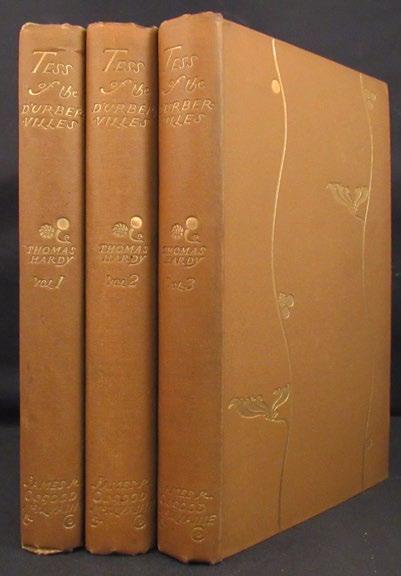
of a mill. Hardy wrote the story to commemorate the 75th anniversary of Trafalgar, it was first printed in an abridged form in “Good Words”. It is Hardy’s only historical novel. Purdy, pp. 31-35; Sterling 427; Sadleir 1115 HBS 66272. $12,500.

21 Joyce, James. FINNEGANS WAKE (London: Faber and Faber, 1939) First Edition, First Issue, Signed by James Joyce and limited to 425 copies only, of which this is number 341. 8vo, publisher’s original red buckram lettered in gilt on spine, t.e.g., other edges untrimmed. Yellow cloth slipcase expertly re-created as the original. 628. A fine copy, very handsome, bright and clean, very well preserved and without wear. The slipcase in beautiful condition.
IMPORTANT FIRST EDITION SIGNED BY JAMES JOYCE. A very desirable copy of this, the best and scarcest issue of the first editions. No book has ever been more ambitiously conceived than Joyce’s FINNEGANS WAKE. If ULYSSES represents the pinnacle of the Modernist movement, FINNEGANS WAKE is a step beyond; it stands in the same relation to ULYSSES as ULYSSES does to A PORTRAIT OF THE ARTIST....—an extension which is also a completely new conception. Joyce envisioned the book as nothing less than a “history of the world.” Seventeen years in the writing, and composed in a sort of meta-language--”an Esperanto for the art of fiction”--it stands as a unique monument to language and literature and the modern age. Slocum and Calhoun A49; Bradbury, The Modern World, 157-176. $18,500.
22 Lawrence, D. H. THE VIRGIN AND THE GIPSY [GYPSY] (Florence: Printed by the Tipografia Giuntina for G. Orioli, 1930) First Edition, one of 810 copies, limited and numbered, printed on Binda handmade paper for Orioli in Florence, Italy. With engraved frontispiece illustration and title-page illustrated with the Phoenix. 8vo, publisher’s original white cloth, the upper cover with Phoenix rising in red, lettered in red on a label to the spine panel, with the printed and pictorially decorted dustjacket. 216, [1] pp. A very fine copy of the book, crisp and clean and near pristine, light mellowing and rubbing to the jacket extremities, still a very pleasing and unusually well preserved copy.
TRUE FIRST EDITION, FIRST ISSUE. The Virgin and the Gipsy is a
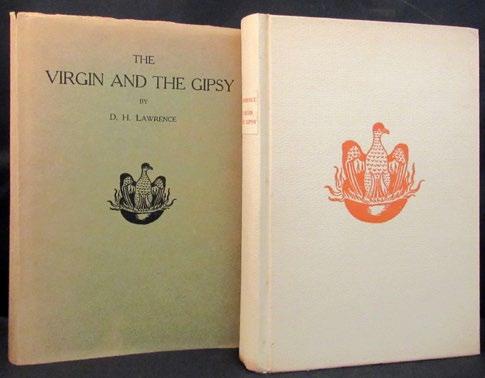
short novel written in 1926 and published posthumously in 1930. Today it is often entitled The Virgin and the Gypsy which can lead to confusion because first and early editions had the spelling “Gipsy”. ‘The story is a romance of blossoming spirit. $850.

23 Trollope, Anthony. THE SMALL HOUSE AT ALLINGTON (London: Smith, Elder and Co., 1864) 2 volumes. First edition, with the first printing points “hobbledehoya” page. 33, line 1 and page 70 paginated as “0.” in Volume I. With the provenance of William Marchbank with his armorial bookplate. With eighteen illustrations on plates by J. E. Millais, R.A. Tall 8vos, in the publisher’s original textured green cloth, all boards handsomely embossed in blind in botanic motif, the upper covers with a large central gilt vignette featuring lettering and floral vines around caged birds, the spines beautifully gilt lettered and decorated in fine Victorian style in a country motif, with brown endpapers printed with ads in black. Now housed in a green cloth slipcase. iv, 312; iv, 316 pp. A very bright and attractive copy well preserved in original state, the text very fresh and clean, a little inconsequential evidence of age or mellowing at the prelims or endleaves, the cloth with a little expected rubbing or age evidence but still very bright with bright gilt, in all a very handsome set of a book seldom found in its original cloth, much less in bright collector’s condition.
AN EXTREMELY APPEALING COPY, FRESH AND BRIGHT AND CLEAN OF A BOOK SADLEIR SAYS IS TYPICALLY FOUND “EXCEPTIONALLY DIRTY”. We are very pleased to point out how well this copy stands as the exception to that rule.
This is the fifth of Trollope’s Barsetshire novels and was written at the height of his creative powers and popularity. It follows two of his best-loved heroines, Lillian and Bell Dale. It concerns the Dale family, who live in the “Small House”, a dower house intended for the widowed mother of the owner of the estate. As with all of Trollope’s novels, this one contains many sub-plots and numerous minor characters. Plantagenet Palliser makes his first appearance, as he contemplates a dalliance with Griselda Grantly, the now-married Lady Dumbello, daughter of the Archdeacon introduced earlier in the Chronicles of Barsetshire.
“SMALL HOUSE” also continues Trollope’s association with artist John Millais. Millais displays on this occasion a refined style with finer detailing and more confidence then we saw last in “ORLEY FARM”. Sadleir 18; HBS 3096. $6750.
Continue on to the next section, American literature
The Last of the Mohicans - An American Classic
James Fenimore Cooper - First Edition - 1826
An Excellent Set in Contemporary Bindings with Provenance
The Most Famous of the Leatherstocking Tales
The Original Owner with a Thomas Jefferson Connection
24 [Cooper, James Fenimore]. THE LAST OF THE MOHICANS: A Narrative of 1757. By The Author Of “The Pioneers” (Philadelphia: H.C. Carey and I. Lea - Chestnut Street, 1826) 2 volumes. First Edition, First Issue with BAL’s state A of the Copyright page in Vol. II and with other points called for. A COPY WITH FINE PROVENANCE AND PRESENTATION INSCRIPTIONS DATED JUNE 1826. With all the blanks called for including the conjugate for the title-page in Vol. II, the first issue points called for are present, Vol. I has the final “I” at “viii” and page 89 is incorrectly numbered 8vo, bound in the printer’s original bindings of calf over blue paper covered boards. xi, [1], 282; [iv], 289 pp. A truly honest copy bound in calf and boards at the time of publication, with wear to the boards and calf backs, boards to Vol.II detached, the usual mellowing to the text-blocks, title-page to Vol.II with a closed tear, a pleasing copy of this monumental American novel, unsophisticated and very rare thus.

A RARE TRUE FIRST EDITION, FIRST ISSUE OF THIS GREAT CLASSIC, A TRUE CORNERSTONE OF AMERICAN LITERATURE, AND ONE OF THE MOST ELUSIVE OF THE IMPORTANT EARLY AMERICAN LITERARY CREATIONS.
James Fenimore Cooper was an avid reader in an age when most literature in America was imported from England. But as an author, he decided early on that he could well do a better job of writing for a growing and distinctly American readership than could his European counterparts. And so, he began the writing of his “Leather Stocking” series of which LAST OF THE MOHICANS is the second book after the introduction of Natty Bumppo in THE DEERSLAYER but the most famous of all the titles in the group and the “first in which the scout...was made the symbol of all that was wise, heroic and romantic in the lives and characters of the white men who made the American wilderness their home....This novel glorified for the many generations of readers, in England, France, Russia and at home, some aspects of American life that were unique to our cultural history.”
Cooper did far more than to imitate the European authors he had read, instead developing a great new American style by which quite quickly he became one of the first and greatest literary giants of the New World. His works reflect themes and emotions unique to a people living on the edge of the great American wilderness and Cooper would prove to be widely read, not only in America, but throughout all of Europe as well. ‘His achievement...the result of brilliant improvisation...was sustained...to the close of a hectic, crowded career. His...fame attests his power of invention...the creation of tension between different kinds of society, between society and the individual, between the settlement and the wilderness, and between civil law and natural rights as these suggest issues of moral and mythic import.’
Cooper’s works remain to this day classics in American literature. “This is the... most famous of the Leatherstocking Tales”. (Grolier 100 Influential American Books, 34).
Concerning the provenance, this copy has a gift presentation dated June, 1826 and is the copy of George C. Shattuck. George Cheyne Shattuck (1783–1854) graduated from Dartmouth College in 1806 and studied medicine at Harvard Medical
School and the University of Pennsylvania, receiving a degree from the latter in 1807. He practiced medicine in Boston, where in 1808 he published Three Dissertations on Boylston Prize Questions for the Years 1806 and 1807 (Sowerby, no. 986), a copy of which he sent to Thomas Jefferson in October 1808. Shattuck established an endowed professorship at the Harvard Medical School and was president of the Massachusetts Medical Society, 1836–40. DAB; Martin Kaufman and others, Dictionary of Medical Biography [1984], 2:675–6; Edward Jarvis, Memoir of the Life and Character of George Cheyne Shattuck, M.D. [1854]).
Dr. Shattuck was known to Thomas Jefferson who wrote to him in 1809: “Washington Mar. 11–09. Th: Jefferson presents his compliments to mr Shattuck and his thanks for the copy of the Boylston prize dissertation which he was so kind as to send him. he shall read it with pleasure in the leisure of Monticello, to which place he [is] now in the moment of departure. he prays mr Shattuck to accept the assurances of his respect. Grolier 34; BAL 3833; Hart; Grolier 100; Oxford American Literature; Johnson, High Spots of American Literature pp 24-25, Spiller & Blackburn 7 $18,500.
F. Scott Fitzgerald’s Great Gatsby - First Edition, First Issue

25 Fitzgerald, F. Scott. THE GREAT GATSBY (New York: Charles Scribners’ Sons, 1925) First edition, first printing, with “chatter”on p. 60, line 16, “northern” on p. 119, line 22, “it’s” on p. 165, line 16, “away” on p. 165, line 29, “sick in tired” on p. 205, lines 9-10, and “Union Street station” on p. 211, lines 7-8 8vo, publisher’s original dark green cloth lettered in gilt on spine, and lettered in blind on the upper cover. Now preserved in a finely produced facsimile of the original dustjacket. 218 pp. A handsome copy, the cloth with no fading, a bit of age evidence, some mellowing to the gilt of the spine panel, an honest copy of an American icon.
SCARCE FIRST EDITION, FIRST ISSUE. Fitzgerald’s most highly acclaimed novel and one of the most iconic American novels of the 20th century. THE GREAT GATSBY, F. Scott Fitzgerald’s finest novel, relates a tale of life, love, infidelity and death among the rich and beautiful residents of Long Island. It has become recognized as a sensitive and symbolic treatment of the themes of modern life, conveying with irony and pathos the legend of the “American Dream” The book is becoming increasingly difficult to find in any first issue format. $3750.
The First American Edition - In the Rare Dustjacket
26 Frost, Robert. NORTH OF BOSTON (New York: Henry Holt and Company, 1915) First Edition Thus, Stated Third edition but actually the second printing of the First Edition Printed in America. 8vo, publisher’s original blue cloth lettered and ruled in gilt on the spine and lettered in gilt within a double-ruled frame on the upper
cover, in the publisher’s original dustjacket printed in black on the upper cover and spine. 137 pp. A fine and handsome copy, only the most minor of mellowing to the tips, the jacket unusually well preserved, whole and without chipping, just a bit of wear at the fold lines and extremely minor rubbing to the spine.
SCARCE IN THIS CONDITION AND IN THE DUSTWRAPPER. THIS ISSUE WAS ACTUALLY THE FIRST REPRINT OF THE FIRST EDITION PRINTED IN AMERICA.
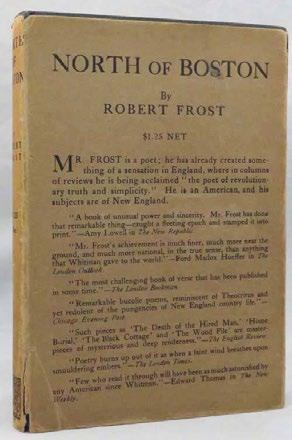
‘...the absence of the spectacular is the essence of the man and the man’s mind. Truth and its beauty grow more surely from the unfolding of normal life than from any sudden heat of collision. Illumination may sometimes strike through in an unexpected flash, but wisdom is the clear light of steady living....what lies behind the poetry of Robert Frost arises from that deeper level where man engages in the unending struggle to adjust spirit to the world and the world to spirit.
It was in NORTH OF BOSTON that he found himself...and in a few quiet poems that follow, the spirit matures. The settings of so many of his poems belong to NORTH OF BOSTON...but the heart of Frost’s poetry is unlimited by place or time...though much of life and its import have tended to come to him...in the garments of country life north of Boston....the substance and meaning of his poetry is human life--moving on, struggling...moving on again.’
The book is vital to his development as a great poet. It remains in all his oeuvre perhaps the most prominent of his books. $1850.
Grandfather’s Chair:
First Edition - Original Cloth - 1841
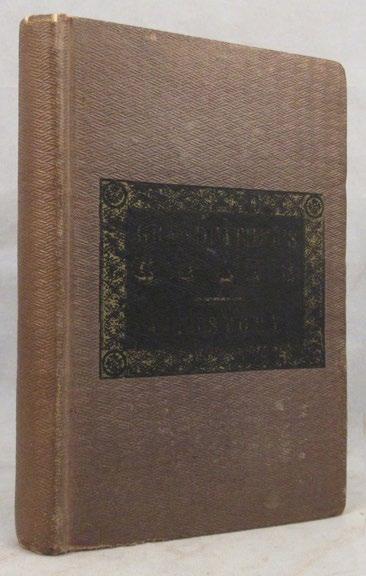
27 Hawthorne, Nathaniel. GRANDFATHER’S CHAIR: A History for Youth (Boston: E. P. Peabody, 1841) First Edition and a true Hawthorne rarity. 12mo, publisher’s original basket-weave grained plum cloth, the upper cover with black paper pastedown label gilt decorated and lettered. vii, 140pp. An especially well preserved copy, the text is near to pristine, the hinges are strong and tight, the cloth with only the most minor evidence of age to the extremities, and as is always the case the gilt on the paper label is dulled.
FIRST EDITION OF THIS TRULY SCARCE ITEM IN THE HAWTHORNE OEUVRE. Also one of his earlier works, printed nine years prior to THE SCARLET LETTER and a decade prior to THE HOUSE OF THE SEVEN GABLES. In these early days Hawthorne wrote primarily for children, for whom he was a wonderfully descriptive teller of tales.
GRANDFATHER’S CHAIR retells real stories from America’s early days by following the history of a chair brought to America from England in 1630 aboard the good ship ‘Arbella’. The chair makes it way through the Colonial and revolutionary periods before finally being purchase by Grandfather at auction. Many famous and infamous people are met along the way. And have no doubt, George Washington sat here!
This early Hawthorne rarity is typically found foxed and worn, this copy is exceptional in its fine condition. BAL 7590; Clark A6.1. $1850.
The Writings of Nathaniel Hawthorne With Illustrations Signed by the Artists on Individual Plates
In Very Beautiful Crushed Levant Morocco Bindings Gilt
The Autograph Edition - Signed by the Author’s Daughter
A Superb Set by the Author’s Most Important Publisher
28 Hawthorne, Nathaniel. THE WRITINGS OF NATHANIEL HAWTHORNE, [With Introductory Notes and Bibliographical notes by H.E. Scudder] and the General Introduction by Rose Hawthorne Lathrop [the author’s daughter]. (Boston and New York: Houghton Mifflin and Company [and] The Riverside Press, Cambridge, 1900) 22 volumes. The Autograph Edition, Designed by Bruce Rogers and Limited to 500 Signed and Numbered Copies of which this is No. 42. The Edition is signed by Rose Hawthorne Lathrop and the Clerk of the Houghton Mifflin Company. Illustrated throughout with plates by American artists. Each Frontispiece plate in two states, both coloured and uncoloured, and each signed by a different artist. Those signed include: Childe Hassam, Ross Turner, Jules Guerin, Howard Pyle, Jesse Willcox Smith, Eric Paper, F.T. Merrill and E.H. Garrett. Over 130 plates are included throughout the 22 volumes. Tall 8vo, very finely bound in especially handsome three-quarter rich dark-turquoise crushed levant morocco over marbled boards gilt, the spines very beautifully decorated with fine and elaborate panel designs gilt within the compartments between raised bands gilt stopped, lettered in gilt in two compartments, marbled endleaves to match, top edges gilt. A very beautiful and very handsome set, very fine and very well preserved and a very special survival thus.
FIRST EDITION OF THIS IMPORTANT AUTOGRAPH EDITION OF THE WORKS OF ONE OF AMERICA’S MOST CELEBRATED AUTHORS. This is a beautifully produced, illustrated and bound set of Hawthorne’s complete works.

Salem’s Nathaniel Hawthorne was from a prominent puritan family dating back before the time of the famous witch trials. He led a solitary life and was of rare sensitivity, thus he resisted the Transcendental movement favored by his contemporaries and developed a style of storytelling all his own. His extremely popular works of fiction, including such classics as THE HOUSE OF THE SEVEN GABLES and THE SCARLET LETTER, are often called masterpieces of New England spiritual history. His shorter works, like Poe’s but with more of a moral significance, helped to develop the short story into a distinctive American genre.
Rose Hawthorne Lathrop was Rose was the daughter of Nathaniel and Sophia Hawthorne. This is a wonderful set, beautifully bound and autographed by as close a descendant of Hawthorne as is possible to find. $3250.
In Our Time - Hemingway’s Second Book - 1927 A Superb Presentation Copy with Fine Provenance Boni and Liveright - Preceeding the Scribner’s First Printing

29 Hemingway, Ernest. IN OUR TIME (New York: Boni and Liveright, 1927) First American Edition, second printing, March 1927. A WONDERFUL SIGNED PRESENTATION COPY WITH EXCELLENT PROVENANCE. 8vo, publisher’s original black cloth lettered in gilt on the spine and upper cover and with gilt geometric decorations on the upper cover. 214, (1) pp. A fine copy, beautifully preserved.
FIRST EDITION, SECOND PRINTING, SIGNED PRESENTATION COPY OF HEMINGWAY’S FIRST BOOK OF STORIES OTHER THAN THE WORK WHICH INCLUDED TEN POEMS. This was the author’s first book published in the U.S., only his second published book and the first that was published for the general trade audience. Fewer than 1400 copies of the first issue of the book were published, and even less of this second issue which is considered to be more rare than the first. It was influenced, as was THREE STORIES AND TEN POEMS (1923) by Ezra Pound and Gertrude Stein, while spokespersons for the “Lost Generation.
There is excellent provenance associated with this copy which was inscribed and presented to Major General Milton Foreman who was a hero in the SpanishAmerican War, the Mexican Border Service Campaign and World War I. It is pprobable that Hemingway met him during the First World War.
‘In the Spanish-American War, he enlisted in the Army as a private in Troop C, First Calvary, on December 5, 1895. He worked his way up the ranks until he was a captain. In the Mexican Border Service, he was a colonel commanding the First Calvary Division of the Illinois National Guard
Colonel Milton J. Foreman, of the Illinois National Guard, received the Distinguished Service Cross for bravery in World War I while serving in France. When his unit came under heavy artillery and machine gun fire, he crept through the German gunfire, laying out telephone wire so that he could tell his artillery where the enemy had its gun positions. Foreman found the enemy gun positions and directed his artillery to lay down a barrage of shells to destroy them.
General Foreman was awarded for bravery the Distinguished Service Cross, the Distinguished Service Medal, Silver Star Citations, French Legion of Honor and the Belgian Order of the Crown. During World War II, Foreman was honored when a merchant liberty ship was named the S.S. Foreman.
When World War I ended, he was discharged and appointed a colonel in the Illinois National Guard. He was promoted to brigadier general on June 23, 1920 and major general on March 19, 1921. Upon Foreman’s retirement, in 1931, he was promoted to Lieutenant General.
General Foreman was one of the organizers of the American Legion and he was elected chairman of its executive committee at the Paris Caucus, at which he represented Illinois. During the Legion’s third national convention in 1921, he was designated as a past national commander by resolution.
Foreman was born on January 26, 1863, in Chicago, Illinois. He was educated here and eventually became an attorney, being admitted to the bar in 1899. He served as a member of the Chicago City Council from 1899 to 1911.
He was very active in politics and civic affairs. Foreman had the confidence of presidents, cabinet members, senators, governors and mayors. He was a bachelor and a collector of rare books. He died on October 18, 1935’ see Seymour “Sy” Brody Connolly 100 $28,500.
Hemingway’s First Published Novel
The Torrents of Spring - First Edition, First Issue, First State An Especially Rare Advance Copy with Original Photograph And With the Publisher’s Typed Statement Affixed - 1926

30 Hemingway, Ernest. THE TORRENTS OF SPRING: A Romantic Novel in Honor of the Passing of a Great Race (New York: Charles Scribner’s Sons, 1926) First edition, First Issue with nine titles listed on the rear panel of the dustjacket. A superb advance copy of the first printing, with an original photograph of Hemingway tipped in and the printed publisher’s biographical statement affixed, announcing that “ “The Sun Also Rises” will be published by Charles Scribner’s Sons in the Fall” 8vo, original black cloth lettered in red on the spine and upper cover. [8], 143 pp. A very fine, especially well preserved copy of Hemingway’s first novel, clean and solid, hinges firm, the jacket with a bit of mellowing caused by time and with a small chip to the tip of the jacket’s spine panel.
FIRST EDITION, FIRST ISSUE, VERY RARE ADVANCE COPY WITH ORIGINAL PHOTOGRAPH AND PUBLISHER’S TYPED STATEMENT AFFIXED ANNOUNCING THE FORTHCOMING PUBLICATION OF “THE SUN ALSO RISES” AND WITH FORD MADDOX FORD’S LAUDATORY COMMENT ON HEMINGWAY. THIS IS THE AUTHOR’S FIRST LONG WORK TO BE PUBLISHED. Although it was written after THE SUN ALSO RISES --”to cool out,” Hemingway explained-- THE TORRENTS OF SPRING was published prior to his more famous novel. It was written as a parody of Sherwood Anderson’s Dark Laughter. “It seems to have started as a knockabout parody of Sherwood Anderson’s mechanized folkware” (quoted in THE HEMINGWAY READER). Written in ten days, it is a satirical treatment of pretentious writers. Hemingway received a mixed reaction to the novella that was sharply critical of other authors. His wife Hadley believed the characterization of Anderson was “nasty”, while F. Scott Fitzgerald considered the novella to be a masterpiece. Hanneman A4a. $18,500.
The Beautifully Bound Deluxe Riverside Press Edition
Illustrated on Nearly Every Page With Fine Engravings
31 Longfellow, Henry Wadsworth. THE POETICAL WORKS OF HENRY WADSWORTH LONGFELLOW ILLUSTRATED [with] THE COMPLETE PROSE WORKS OF HENRY WADSWORTH LONGFELLOW With His Later Poems Illustrated [and] With a Biographical Sketch by Octavius B. Frothingham. (Boston: The Riverside Press for Houghton, Mifflin and Company, [circa 1886]) 3 volumes. The Very Fine Deluxe illustrated folio edition of Longfellow’s complete works. Illustrated with very handsomely engraved portrait frontispieces with facsimile signatures in each volume, profusely illustrated throughout with hundreds of engravings by various noted artists, many of which are on full page plates, many others are half-page in size, and still other smaller engravings are present throughout the volumes along with intricately designed chapter headings. Folio, in the publisher’s best and most deluxe and impressive binding of full dark brown morocco handsomely decorated with wide ornate panels of inlaid smooth morocco double-ruled in gilt and with large gilt corner tools to all covers, the upper covers with a full gilt decorations featuring a harp and flowers and ornate gilt lettering. The spines are decorated with gilt-ruled raised bands, panels in gilt with fine gilt tools in the center of each compartment,
two compartments with bright gilt lettering on smooth morocco labels, beveled board edges gilt rolled, very wide beautifully gilt paneled turn-ins, fine brown moire silk pastedowns and end-leaves, and all edges richly gilded. xvi, 488; xvi, 489-928; viii, [2] 9321407 [2] pp. An unusually fine, very handsome and pleasing set of this stunning edition, very well preserved indeed. The bindings are strong and firm, bright and clean and near as pristine, internally they are equally fine, fresh, bright and clean with not even a hint of foxing or any real evidence of use or age.
FIRST OF THIS FINE EDITION OF VERY CLASSIC AMERICAN POETRY BEAUTIFULLY PRESENTED IN AN IMPRESSIVE DELUXE FOLIO FORMAT. A very beautiful and imposing early edition of Longfellow’s great American poetry. The tomes are extensively illustrated with exceptional engravings by numerous artists which represent a wide variety of styles. This edition is made all the better by the inclusion of Longfellow’s prose, later poems (many of which were not included in editions issued during his lifetime) and Ms. Frothingham’s fine and concise biographical sketch.
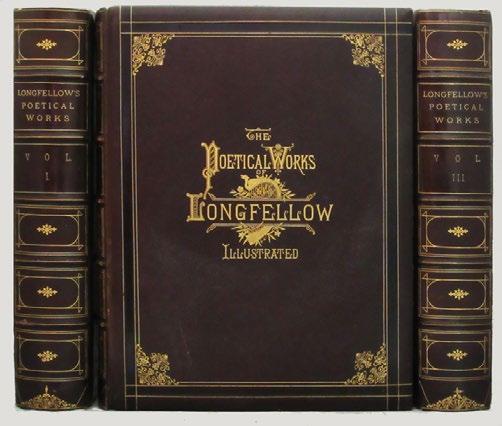
Louis Untermeyer, who writes of Longfellow’s poetry: “It expresses a kindliness which is spontaneous, and a homeliness which is winning because it is so straightforward. It retains its popularity because it is unaffectedly clear, unashamedly tender, and unshakably serene.” Here we find all of his groundbreaking works: such as Song of Hiawatha, Evangeline, Tales of a Wayside Inn, Paul Revere’s Ride, Courtship of Miles Standish, the Village Blacksmith, Poems on Slavery, and so very many others, and all quite impressively illustrated. $1250.
The Grapes of Wrath - 1939 - A Handsome Copy
First Edition in the Original Dustjacket
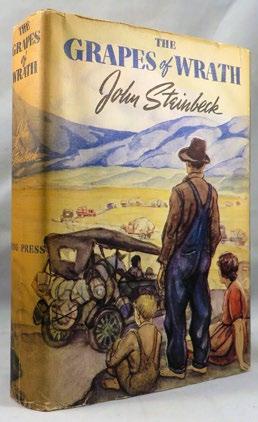
John Steinbeck’s Pulitzer Prize Winning Novel
32 Steinbeck, John. THE GRAPES OF WRATH (New York: The Viking Press, 1939) First Edition. 8vo, publisher’s original pictorially decorated tan cloth in original first issue dustjacket, with price and “First Edition” statement both present. (vi), 619 pp. A handsome, bright and clean copy, the dustjacket whole and without tears, light evidence of shelving over time, the backstrip of the dustjacket just a touch mellowed by age, clean and bright internally, solid and very well preserved.
AN IMPORTANT FIRST EDITION AND PERHAPS THE GREATEST BOOK WRITTEN BY THIS NOBEL PRIZE WINNING AUTHOR. John Steinbeck won the Pulitzer Prize for this novel of migrant workers in America. The story of the Joad family, simple people living close to nature, whose lives are disrupted by the malevolent forces of drought, market conditions and human greed. The novel graphically demonstrates the dangers to society when the vital like between rural man and the Earth is broken.
The condition of this copy, in the pictorial jacket, is quite pleasing indeed. $6850.
Twain’s Masterpiece of American Literature
Huckleberry Finn - First Edition in the Original Cloth
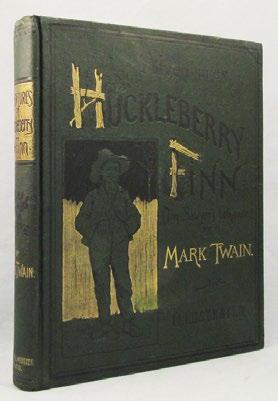
A Handsome and Pleasing Copy - Very Early Issue Points
33 Twain, Mark. THE ADVENTURES OF HUCKLEBERRY FINN (New York: Charles L. Webster and Company, 1885) FIRST AMERICAN EDITION, FIRST PRINTING with the very early issue points: “was” for “saw” on p.57; the Illustrations list p.[13] showing the “Him and another Man” plate as appearing on p.88; p. 9 with ‘Decided’ in the heading to Chapter VI, later corrected to ‘Decides’; p. 155 with the final “5” dropped, the final leaf blank, no signature mark to p. 161. With 174 black and white illustrations by E.W. Kemble. Square 8vo, publisher’s original green cloth elaborately decorated in gilt and black on the covers and spine, now housed in a custom slipcase with wraparound chemise. 366 pp. A handsome, well preserved and pleasing copy of this enduring classic. The cloth still nice and dark green with the gilt and black still strong on the upper cover, the giltwork on the spine well preserved, only very minor evidence of age or use to the tips and edges, the text-block very clean and the binding tight and firm. A fine survival of a cornerstone work, with some very skillful and near invisible sophistication, in collector’s condition.
THE FIRST EDITION OF ONE OF THE MOST IMPORTANT AND GREATEST BOOKS IN AMERICAN LITERATURE. “ALL MODERN AMERICAN LITERATURE COMES FROM ONE BOOK BY MARK TWAIN CALLED HUCKLEBERRY FINN”--Ernest Hemingway.
Along with TOM SAWYER, HUCKLEBERRY FINN is considered the stepping stone to modern American literature. And along with Tom Sawyer, for the first time, the hero of the novel was a boy. These books are landmarks and Hemingway often offered his opinion that the modern novel would have been impossible without them. With Whitman’s LEAVES OF GRASS and Melville’s MOBY DICK, they provide us with a view of America transcending its past and beginning its future. BAL 3415; Grolier American 87; Johnson, pp. 43-50; Peter Parley to Penrod, pp. 75-6
$8500.
The Adventures of Tom Sawyer - The Scarce London Issue
A Cornerstone of American Literature - 1876
34 Twain, Mark. THE ADVENTURES OF TOM SAWYER (London: Chatto and Windus, 1876) RARE AND TRUE FIRST PRINTING. The True First Edition, English issue preceding the American issue thus the earliest issue available. 8vo, publisher’s original red cloth, ornately decorated on the upper cover and spine in gilt and black. [viii], 341, [1[ pp. Internally quite clean and still fresh, the original red cloth with some general evidence of age, some typical evidence of shelving or use, the original spine panel laid down, a well-preserved copy of this rare book.

FIRST EDITION, FIRST PRINTING OF THE SCARCE LONDON ISSUE, PRECEDING THE AMERICAN AND THUS THE EARLIEST ISSUE ATTAINABLE OF THIS GREAT AMERICAN CLASSIC.
TOM SAWYER is now considered to be, along with HUCKLEBERRY FINN, one of the great stepping stones to the modern American novel. It, like Whitman’s LEAVES OF GRASS and Melville’s MOBY DICK, typifies and describes the American spirit. It lies at that very special moment in history
when America, having challenged its past sets off on the new adventures that will force it into the coming century and the great expansion of its democratic spirit. To this day, it remains a cornerstone of American literature. BAL 3367; Johnson p. 37 $8500.

35 Twain, Mark. LIFE ON THE MISSISSIPPI. (Boston: James R. Osgood, 1883) First Edition, Early State. Blanck’s intermediate B, with the tailpiece of Twain in flames on p.441 not present, and with caption on p.443 reading “The St. Charles Hotel”. Profusely illustrated throughout. Tall 8vo, publisher’s original decorated cloth with black stamped decorations and gilt pictorial vignettes on the upper cover, the spine decorated in black and with a large gilt pictorial vignette, lettered in gilt, a.e.g., protected in a fine slipcase 624 pp. A very fine copy, uncommonly fresh and well preserved, the cloth is a rich brown with bright gilt and only the lightest evidence of age, internally sound and very clean. A superior copy.
ONE OF TWAIN’S BEST BOOKS AND A RARE AND HANDSOME COPY IN ORIGINAL CLOTH OF THIS IMPORTANT FIRST EDITION. Twain writes about his home and his muse-the great Mississippi. “As a dwelling place for civilized man it is by far the first upon our globe.” (preface)
In this largely autobiographical narrative, Twain gives us a vivid account of his experiences on the great river. LIFE ON THE MISSISSIPPI is brilliant firsthand account of the steamboat age, the science of river piloting, and the life of the river itself from the point of view of those who made their living navigating it.
The book is also an account of the changes of time, both to a man and to a way of life. The first part of the book recounts Twain’s youthful days as a steamboat pilot before the American Civil War. Later in the book Twain recounts a trip along the Mississippi River from St. Louis to New Orleans many years after the war, taken by a now mature and successful author.
LIFE ON THE MISSISSIPPI is a truly wonderful book and a valued piece of the American legacy. B.A.L.3411, Queens Quorum p.45. $2150.
Walt Whitman - A Fine Set of the Complete Writings
10 Volumes - Beautifully Bound in Morocco, Gilt Extra
One of a Limited Number and an Important Set of the Works
36 Whitman, Walt. THE COMPLETE WRITINGS...Issued under the editorial supervision of his Literary Executors, Richard Maurice Bucke, Thomas B. Harned, and Horace L. Traubel. With additional bibliographical and critical material prepared by Oscar Lovell Triggs, Ph.D. (New York: The Knickerbocker Press for G. P. Putnam’s Sons, 1902) 10 volumes. The Paumanok Edition, one of only 300 numbered sets printed on Ruisdael handmade paper. With illustrations in gravure and aquatint on japon vellum in each volume, colour frontispiece of Whitman to Volume I, tissue guards intact as issued. Large, thick 8vo, beautifully presented in fine period bindings of three-quarter crushed honey morocco over subtle marbled boards, the turnovers gilt ruled at the borders, the spine with art nouveau decorations incorporating raised bands gilt decorated and gilt ruled, the largest compartment with fine gilt and black tooled art nouveau intertwining decorations, one compartment lettered in gilt, t.e.g., others uncut. xcvi, 294; xiii, 323; vii, 297; xi, 324; vii, 301; v,318; v, 281, v, 300; xviii, 230; v, 309 pp. A very handsome, fine and bright, attractive and especially well preserved set.
A RARE AND BEAUTIFUL
SET, on fine paper with Gothic titles, illustrated title pages and finely engraved portraits of the author, the people in his life and other important personages of the age. There is a fine introduction to LEAVES OF GRASS and the set also includes an important biography of the poet by Bucke, Harned, and Traubel. There are here presented, the greatest poem of America in its most complete format, and volumes of the wonderful prose writings of Whitman including the inclusion of SPECIMEN DAYS and other significant works.
Whitman’s LEAVES OF GRASS portrayed America at the crossroads between an old world, soon to be cast off, and the new world of our future present. With the publication of LEAVES OF GRASS in 1855, Whitman, the poet of democracy, ushered in a new era in American letters, describing specifically American experiences in a distinctly American idiom. From its first publication in 1855, he had complete confidence in the greatness of both the book and its author.
“Always the champion of the common man, Whitman is both the poet and the prophet of democracy. The whole of LEAVES OF GRASS is imbued with the spirit of brotherhood and a pride in the democracy of the young American nation. In a sense, it is America’s second Declaration of Independence: that of 1776 was political, this of 1855 intellectual. ...The poems are saturated ‘with a vehemence of pride and audacity of freedom necessary to loosen the mind of still-to-be-formed America from the folds, the superstitions, and all the long, tenacious, and stifling anti-democratic authorities of Asiatic and European past’. To the young nation, only just becoming aware of an individual literary identity distinct from its European origins, Whitman’s message and his outspoken confidence came at a decisive moment.
LEAVES OF GRASS was Whitman’s favorite child. From the time of its original publication,...until the year of his death, he continued revising and enlarging it. If (his) reputation has fluctuated over the years and his position among, if indeed not at the head of, the list of great American poets was not assured until some time after his death, there was never any doubt of the matter in his own mind. ‘I know I am deathless’, he wrote. ‘Whether I come to my own today or in ten thousand or ten million years, I can cheerfully take it now, or with equal cheerfulness I can wait.’ Time has vindicated his conviction.” PMM
One of the rare opportunities to acquire this comprehensive set from one of the greatest of American poets. Myerson $12,500.
Walt Whitman - Leaves of Grass - His “Favorite Child”

The Handsome Reissue of the First Boston Edition - 1860-61
Arguably the Greatest Work in American Literature
37 Whitman, Walt. LEAVES OF GRASS (Boston: Thayer and Eldridge, 1860-61 (spurious)) Pirated issue of the Thayer and Eldridge edition. Illustrated with and engraved frontispiece portrait of Walt Whitman at an early age. 8vo, publisher’s original maroon cloth lettered in gilt on spine, title and pictorial decorations in blind on both covers. iv, 456 pp. An essentially fine copy, very well preserved, the binding clean and strong, the hinges in excellent order, the text-block essentially as pristine and unread, previous owner’s name stamped inside.
A VERY HANDSOME COPY OF THE WORTHINGTON REISSUE OF THE BOSTON EDITION OF 1860-61. The first Boston printing was the first general trade published issuance of LEAVES OF GRASS. The edition included 122 new poems and two new sections. This is an early reissue of one of the most important editions of this great American literary
work which remains attainable.
Whitman began this edition with “Proto-Leaf”[“Starting from Paumanok”] a lovely apologia for his work. And this edition has the two very important clusters-”Enfans d’Adam” and “Calamus”--focusing on love.
Whitman’s LEAVES OF GRASS is, arguably, the greatest work in all of American literature. LEAVES OF GRASS portrayed America at the crossroads between an old world, soon to be caste off, and the new world of our future present.
With the publication of LEAVES OF GRASS in 1855, Whitman, the poet of democracy, ushered in a new era in American letters, describing specifically American experiences in a distinctly American idiom. From its first publication in 1855, he had complete confidence in the greatness of both the book and its author.
“Always the champion of the common man, Whitman is both the poet and the prophet of democracy. The whole of LEAVES OF GRASS is imbued with the spirit of brotherhood and a pride in the democracy of the young American nation. In a sense, it is America’s second Declaration of Independence: that of 1776 was political, this of 1855 intellectual. ...The poems are saturated ‘with a vehemence of pride and audacity of freedom necessary to loosen the mind of still-to-be-formed America from the folds, the superstitions, and all the long, tenacious, and stifling anti-democratic authorities of Asiatic and European past’. To the young nation, only just becoming aware of an individual literary identity distinct from its European origins, Whitman’s message and his outspoken confidence came at a decisive moment.
LEAVES OF GRASS was Whitman’s favorite child. From the time of its original publication,...until the year of his death, he continued revising and enlarging it. If (his) reputation has fluctuated over the years and his position among, if indeed not at the head of, the list of great American poets was not assured until some time after his death, there was never any doubt of the matter in his own mind. ‘I know I am deathless’, he wrote. ‘Whether I come to my own today or in ten thousand or ten million years, I can cheerfully take it now, or with equal cheerfulness I can wait.’ Time has vindicated his conviction.” PMM $1050.
Continue to the next section, Unique, Extraordinary, Unusual, Unexpected.
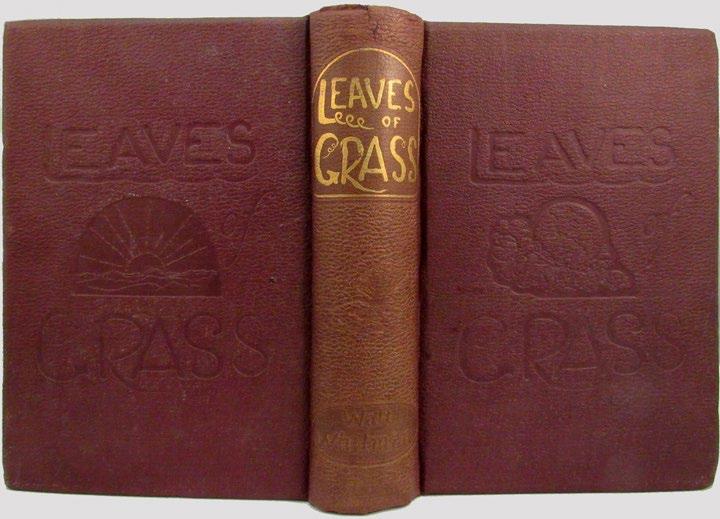
The Gutenberg Bible - Printed With Moveable Type
The Birth of Printing and the Dawn of the Modern Age
An Especially Fine Leaf From the First and Greatest Printed Book
38 [Gutenberg, Printer. Bible, in Latin]. A LEAF FROM THE GUTENBERG BIBLE: From the Book of Jeremiah [25:19 to 27:6] (Mainz: Johann Gutenberg and Johann Fust, ca.1450) A single, highly important leaf from the famed 42-line Bible, the first book printed from moveable type, A Noble Fragment. “Bull’s Head” watermark, printed in gothic letter, double column, two initial ‘I’s, book headers and chapter numbers rubricated in alternating red and blue ink. Capitals highlighted with red strokes. Rubricator’s guidelines in blackbrown ink to upper blank margins in a neat German hand. Folio (390 x 286mm); 42-lines, double column; type: 1:140G, enclosed in a full blue morocco foldover case and protected behind white mounting board. The case is lettered on the top in gilt. Single leaf of the first book printed with moveable type. An especially fine and handsome specimen, remarkably clean, well-margined and rubricated with only very minor evidence of age, the binding also in fine condition.
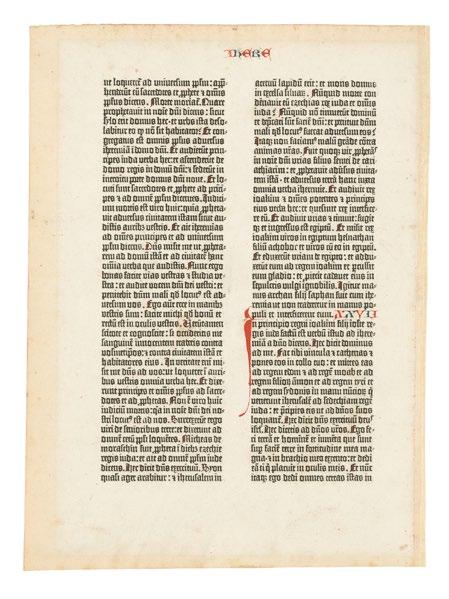
A WONDERFUL LEAF FROM THE FIRST BOOK EVER PRINTED WITH MOVEABLE TYPE AND THE MOST FAMOUS OF ALL PRINTED BOOKS. AND A LEAF IN EXCELLENT CONDITION, REMARKABLY CLEAN, WELL-MARGINED AND HANDSOMELY RUBRICATED. This leaf features a section from the Old Testament of St Jerome’s Vulgate: Jeremiah 25:19 to 27:6, mentioning the Seventy Years of Captivity of the tribe of Judah, Jeremiah being threatened with death and God’s command that the tribe of Judah serve King Nebuchadnezzar of Babylon. The leaf has been identified as vol. II, quire 9 (leaf 3), fol. 83; the Bull’s Head (type I or II) watermark suggests this was a first setting.
The Gutenberg Bible may be described without the slightest exaggeration not only as the earliest but also the greatest printed book in the world. It is the first book from the printing press, having been preceded only by a few trial pieces, single leaves, almanacs and grammatical booklets of which merely stray fragments remain.
It is, as well, one of the most beautiful books ever printed. The quiet dignity of those twelve-hundred or so pages of bold, stately type, the deep black ink, the broadness of the margins, the glossy crispness of the paper, may have been equaled, but they have never been surpassed; and in its very cradle, the printer’s art, thanks to the Gutenberg Bible, shines forth indeed as an art as much and more than as a craft.
Last but not least, the Gutenberg Bible is the first printed edition of the Book of Books. The mere fact that in the Rhine valley in 1455 the first book to be printed should have been the Bible tells its own story. “While Gutenberg and Fust were actually at work, the fall of Constantinople in 1453 announced the end of an old world and the dawn of modern thought. Did Gutenberg realize that by setting the Holy Text in type he was heralding one of the greatest movements of human thought in the history of the civilized world?” (S. De Ricci).
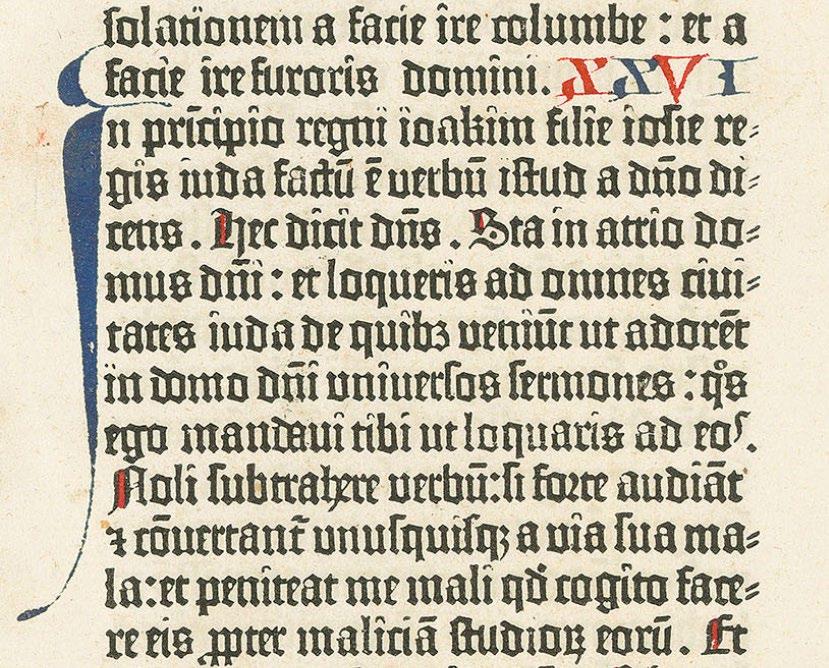
In 1872 the second Gutenberg Bible to be sent to America was shipped along with these eloquent instructions from Henry Stevens of London; “Pray, Sir, ponder for a moment and appreciate the rarity and importance of this precious consignment from the old world to the new. Not only is it the first Bible, but it is the first book ever printed. It was read in Europe half a century before America was discovered. Please suggest to your deputy that he uncover his head while in the presence of this great book. Let no custom house official, or other man in or out of authority, see it without first reverently raising his hat. It is not possible for many men to touch, or even look upon a page of a Gutenberg Bible.”
Hundreds of volumes, indeed whole libraries have been written about the invention of printing and about Gutenberg— of the struggle to design letters, to discover a metal that would hold clear cut edges and stand pressure; to find paper and a formula for ink that could be applied to it by type, to perfect a press that would bring uniform contact, etc.
The Bible is not only the oldest printed book--the most reprinted book--the most translated book... it is, quite properly, the most sought-after of books by bibliophiles, and the most expensive. The last public sale, of a single volume of the two which had originally been issued (the Old Testament and the New Testament) exceeded $5,250,000.
This leaf—one of the ‘Noble Fragments’, so named by the book collector A. Edward Newton (1864-1940)—comes from an imperfect copy once in the Mannheim library of Carl Theodor von Pfalz-Sulzbach (1721-94), Electoral Prince of Palatinate and later Bavaria. In 1803, the copy was transferred, with Carl Thedor’s other books, to the Royal Library of Munich. It was thence sold as a duplicate in 1832 and purchased by Robert Curzon, Baron Zouche (1810-73). Next sold at Sotheby’s in 1920, the copy was acquired by Joseph Sabin and, subsequently, by the prominent antiquarian bookseller Gabriel Wells. Wells removed the eighteenth-century binding with the gilt Palatine arms and subdivided the copy into smaller fragments or individual leaves. He sold these separately. Many are now preserved in institutional libraries (see White, Editio Princeps, p.135). In the years since, individual leaves, rather than longer excerpts, have been offered for sale. The ‘Noble Fragments’ are the closest a dedicated bibliophile can get to acquiring this monument of Western printing.
Gabriel Wells intended that multiple collectors and institutions could have the opportunity to own “A Noble Fragment” of this Supreme Book. The present leaf is a superb example and a rare opportunity to acquire a specimen of the greatest printed book in the history of humankind. HC *3031; BMC I p. 17; GW 4201; Goff B526. $137,500.

The Famous Star Trek Film “Bloopers” of the 1960s
An Important Example in the History of Television
39 [Star Trek; Science Fiction; Television Industry]; [Roddenberry, Gene]. [STAR TREK FILM REEL] Being an Original Reel of 16mm Film Containing the Famous But Highly Elusive “Blooper” Footage. [With] A Digitalized Recording of the Contents on Modern Media ([Holywood]: [Desilu Studios, unpublished], [Circa 1969-1971]) A reel of original black and white 16mm film containing a film print of the full footage of the blooper reels Roddenberry had assembled following seasons one and two of STAR TREK (September 8, 1966 to March 29, 1968). Roughly fifteen minutes of black and white footage from film originally rescued from the cutting-room floor at Deslu Studios. On a contemporary 12.5 inch film spool, and in a film can from the same period. The digital print is made from the actual film provided, and is on modern “thumb-drive” flash media. The celluloid film appears to be very well preserved, there is no odor of acetate or evidence of brittleness associated with degraded film, the actual projected images range from scene to scene but are, as in virtually all known examples, generally of fairly low quality. The history of the their creation and early distribution explains this.
A VERY ENJOYABLE, AND YET ALSO AN IMPORTANT HISTORICAL ITEM FROM THE MOST FAMOUS TELEVISION SCIENCE FICTION SERIES OF ALL TIME. STAR TREK has lived on to be a cultural phenomenon with an almost 60 year life comprised of twelve television series, twelve major motion pictures, and a countless array of books, graphic novels, parodies, and various merchandise. In the history of modern Science Fiction only STAR WARS rivals its popularity.
The STAR TREK bloopers were also the first generally viewed or distributed films of their kind. In the decades since, bloopers have become big business, spawning a popular television series and commonly shown at the end of movies such as the Marvel film series and Dreamworks productions. But prior to STAR TREK, unusable footage such as this was in virtually all cases simply discarded.
The making of the STAR TREK Blooper Reels began as a labor of love. Series creator Gene Roddenberry hand-assembled the first original reel from film scraps rescued from the cutting room floor of things such as goof-ups, horseplay, practical jokes, etc. This first reel was made to show to the cast, production staff, and other studio personal at a 1966 Desilu Christmas party. It was a hit, and he had a few copies made to give as gifts to the studio execs. At the conclusion of season one, he created a second reel using film from reel one combined with additional new footage from the episodes produced after Christmas. Copies of this reel were also produced, again as gifts to studio execs. Another reel was made using clips from season two.
STAR TREK was canceled in 1968, but knowing it had a broad base of mostly well educated fans the studio heavily promoted it for syndication. These afternoon “reruns” quickly gave the series a second life. Roddenberry began as early as 1969 going to colleges to give public speaking appearances and occasionally brought along his copies of the popular “bloopers”. These appearances eventually led to the early S.T. conventions, where Roddenberry would speak and often show his film reels. Eventually, as the conventions grew in popularity, copies were made from Roddenberry’s copies for wider distribution. And occasionally copies of those copies were made to sell to the devoted fans. While the original broadcast episodes of the series were protected by copyright, the editing room scraps were not. The conventions could show these as
they pleased; and in fact the series owners (by this time Paramount/Gulf Western) encouraged it as free advertising for the franchise; they would later try to clamp down on this, but the genie was already out of the bottle.
The distribution reels being made from Roddenberry’s already well-loved and often-shown originals is what accounts for the generally poor audio and video to be found on the film. Fan complaints about the viewing quality go back as far as the early 1970s. No official effort to restore or market the bloopers has ever been made, though parts of them showed up on unauthorized VHS anthologies in the 1980s and later on unauthorized DVDs.
The reel of film offered here contains the full season one reel combined with the full reel from season two, making for just over 15 minutes of viewing pleasure. It is also an uncommon example as it was produced in black and white. The bloopers themselves provide a rare behind-the-scenes glimpse not only into STAR TREK, but into the television industry of the era. They show us a typically good-natured group of fun and creative people who seem to be genuinely enjoying their work. Many of the scenes are physical mishaps, such as tripping, falling, dropping things, or walking into doors (that happens a lot). Others are line flubs and slips of the tongue, and many more are the cast of actors just goofing around, horse-playing, or pulling gags on one and other. Much of the activity is clearly from a different era and would be considered highly “workplace inappropriate” by today’s standards! $2500.
One of the Very Earliest and Most Rare of the Artist’s Works
Gustave Doré - Trois Artistes Incompris et Mecontens
One of the Earliest “Comic Books” Published Paris - Chez Aubert & Cie. - 1850-1851
40 Doré, Gustave. TROIS ARTISTES INCOMPRIS ET MÉCONTENS Leur Voyage En Province.....Et Ailleurs
!!. Leur Faim Dévorante et Leur Déplorable Fin (Paris: Chez Aubert & Cie, [1850-51]) First Edition, First Issue of one of the two earliest and most rare of all Doré’s illustrated books. Only Les Travaux d’Hercule precedes this book, and like the Trois Artistes Incompris et Mecontens is very rarely if ever seen in commerce. Illustrated with an engraved title-page as the upper cover illustration of the book, and over 150 woodcut illustrations throughout. Folio, publisher’s original and earliest binding of pictorially illustrated yellow paper over boards, the upper cover with allover illustrations printed in red and black. [1], 25 pp. A well preserved and handsome copy of this very rare and fragile book, some expert and unobtrusive strengthening at the tips and edges, a book seldom if ever encountered, and even then, nearly always with very considerable wear and breakage.
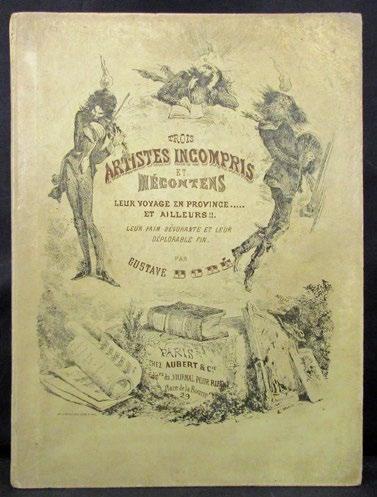
FIRST EDITION OF ONE OF THE EARLIEST AND MOST RARE OF DORÉ’S ILLUSTRATED WORKS. ‘At 15 years of age Doré had begun his career working as a caricaturist for the French paper Le journal pour rire. Wood-engraving was his primary method at this time. In the late 1840s and early 1850s, he made several text comics, like Les Travaux d’Hercule (1847), Trois artistes incompris et mécontents (1850-1), Les Dés-agréments d’un voyage d’agrément (1851) and L’Histoire de la Sainte Russie (1854), but subsequently went on to win commissions to depict scenes from books by Cervantes, Rabelais, Balzac, Milton, and Dante. He also illustrated “Gargantua et Pantagruel” in 1854.
‘Trois Artists is a fascinating book...but dating the Trois Artistes original is a bibliographical challenge. The earliest Journal pour Rire advertisement was in November 29, 1850 and the book itself has a Dec. 1850 date in the publisher’s catalogue. The second larger Journal pour Rire advertisement was dated January 31, 1851, and the book was listed by
February 11, 1851 in Bibliographie de la France. Whether December or January, the book remains, along with Les Travaux d’Hercule, the most rare of Gustave Doré’s illustrated books and one of the earliest “comic books” produced.
Gustave Doré (1832-1883), was described by Saturday Review as “The most startling art phenomenon in Europe; his genius at each turn changes, like the colors in a kaleidescope, into something new and unexpected.” The Fine Arts Quarterly Review also wrote: “Doré is a great and marvelous genius, a poet a nation produces once in a thousand years. He is the most imaginative, the profoundest, the most productive poet that ever sprang from the French race.” These are 1860s quotes from England about a French artist. What did Doré actually do? He created a series of dozens of literary folios with thousands of full-page engravings that are still being borrowed today in hundreds of popular culture genres. The Doré phenomenon was all the more remarkable because he was being viciously attacked by British elitists like John Ruskin, who asserted that Doré was the Devil, come to destroy the morality of the British public who were unsophisticated peasants. But those “unsophisicated peasants” who admired Doré art included the Queen of England, the Prince of Wales, the Poet Laureate, Charles Dickens, plus Leo Tolstoy, Mark Twain, not to mention the Pope. Doré’s dramatic, mystical, otherworldly imagery transcended dimensions of the physical and the spiritual.
Consider that Gustave Doré, at the age of 15 years, and a diminutive teenager walked into the office of Charles Philipon to show his drawings. It is said that he looked to be about 12. Philipon was mesmerized as Doré created new drawings with lightning-fast rapidity right before his eyes. Shortly thereafter, a book appeared with a most curious introduction by the Aubert Publishing Company that read, “The Labours of Hercules was written, drawn, and lithographed by a 15-yearold artist, who has no teacher or art training.” Thus began the art career of the most prolific and popular illustrator of all time. He wrote and drew several “comic books” before he began the transition to Literary Folios, Painting & Sculpture. But the only other edition of Doré’s Hercules in 145 years was a German edition in 1922. Charles Philipon’s company Aubert contracted with Doré’’s father to hire the boy to draw for his Journal pour Rire and Doré had over a thousand engravings published while still a teenager. In 1850 TROIS ARTISTES INCOMPRIS ET MÉCONTENS (Three Misunderstood Malcontent Artists), with 155 drawings was published. One of the two earliest, and now most rare, of the young genius’s books. And one of the earliest of all “comic books”. $5500.
The Chronickles of Engruerrand de Monstrelet
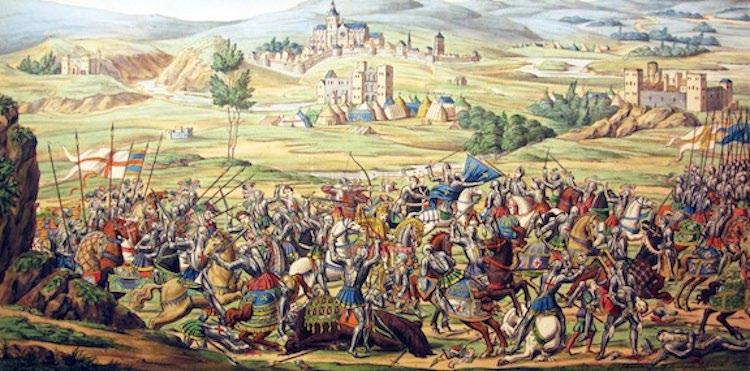
Kingdom of France as well as in Other Countries. A History of Fair Example and Great Profit to the French, Beginning in the Year MCCCC. Where That of Sir John Froissart Finishes, and Ending at the Year MCCCLXVII. And Continued by Others to the Year MDXVI. Translated by Thomas Johnes, ESQ. (London: Hafod Press, 18091809) 5 volumes. FIRST EDITIONS of Johnes’ translations. LARGE PAPER, FOLIO COPIES, ONE OF ONLY SIX SETS WITH THE PLATES IN TWO STATES, both handcoloured and in sepia. Of the large paper sets issued in only 25 sets total, 19 were issued without the coloured plates. This then is one of the very rare copies with coloured plates and one of only six thus. Extensively illustrated with very fine plates issued in two states, both in sepia and hand-coloured and illuminated, 102 plates total. Large Folio, bound in full dark-green crushed morocco, the spines lettered in gilt between raised bands of the spines. Each volume is housed in a cloth covered open-end slipcase. A very handsome set of this rare work. Some weakness to a few hinges.
VERY RARE LARGE PAPER FIRST EDITION COPIES. ONE OF ONLY SIX COPIES PRINTED. Johnes’s translation was the standard for most of the nineteenth century. “Froissart might be called the great interviewer of the Middle Ages. The newspaper correspondent of modern times has scarcely surpassed this medieval collector of intelligence. He traveled extensively in the various countries of Europe; he conversed with gentlemen of rank everywhere; and he had the remarkable knack of persuading those about him to divulge all he wanted to know. He learned the details of battles from both sides and from every point of view. He delighted in the minutest affairs of every cavalry skirmish, of the capture of every castle, and of every brave action and gallant deed. He lived from 1337 to about 1410, and wrote chiefly of contemporaneous events. The “Chronicles” are universally considered as the most vivid and faithful picture we have of events in the fourteenth century.... As a picture of the most favorable side of chivalry, the work has no equal” (Adams, Manual of Historical Literature, pp. 334-5).
$10,500.
Autograph Letters from Forster, Landor, Mitford and Others
Exquisitely Bound and Extra-Illustrated With Engravings

James T. Fields “Portraits” of His Friends and Peers
Yesterdays with Authors - Boston - 1886
42 [Dickens, Charles] Fields, James T. YESTERDAYS WITH AUTHORS (Boston: Houghton, Mifflin and Company at the Riverside Press, 1886) One volume expanded to two. A UNIQUE COPY, EXTRAILLUSTRATED AND WITH AUTOGRAPH LETTERS. With the eleven engraved original portraits featuring handwriting facsimiles and OVER ONE HUNDRED AND TWENTY extra engraved portraits and views from various sources, AND WITH SEVEN ORIGINAL MANUSCRIPT NOTES OR LETTERS BOUND IN. Crown 8vo, in very fine and luxurious full chocolate crushed morocco by the Monastery Hill Bindery, the covers with double-frames composed of 5 gilt ruled lines, the four corners with large gilt tooled decorations in a vine, leaves and berries motif, the spines with six double-gilt framed compartments separated by gilt-ruled raised bands, four tooled with gilt leaves in the corners, two compartments lettered in
gilt, additional gilt rule at the heads and tails of the spine, gilt stippled board edges, the turn-ins with wide gilt panels gilt decorated in a geometric motif surrounding a all-over green morocco inlay with geometric frame featuring elaborate gilt floral corners, fine dark-green silk end-leaves, top edges gilt. The bindings protected by felt-backed cloth covered chemises and encased in matching felt lined, morocco backed slipcases with raised bands and lettering in gilt in two of the compartments. 250; [2] 253-419 pp. A beautiful set in very fine condition, the slipcases only with some trivial rubbing.
A UNIQUE AND EXQUISITE COPY, WITH OVER A HUNDRED EXTRA-ILLUSTRATIONS AND FINE MANUSCRIPT MATERIAL INCLUDED. The author’s literary portraits of his friends is here greatly enhanced with the seven bound in notes and letters. There is a four page signed and dated letter by the author, James T. Fields, a one page note on printed stationery, dated and signed by Dickens’ longtime friend and biographer John Forster; a two page literary letter on blue paper dated and initialed by Charles Dickens in 1856; a clipped dated signature by English writer Mary Russell Mitford; a three page letter in the hand of Miss M. R. Mitford; a one page signed and dated note by English Poet Bryan Waller Procter; and a signed manuscript note by poet, author and activist Walter Savage Landor.
James T. Fields was a prolific American writer and contemporary and friend of the Transcendentalists and other important New England authors as well. Here he gives us literary biographies and commentaries on Thackeray, Hawthorne, Dickens, Wordsworth, Miss Mitford, and Bryan Proctor (who wrote under the pseudonym of ‘Barry Cornwall’. There is within these pages much commentary on other writers and famous persons, such as Alexander Pope, Shakespeare, and others. Added to all of this in the way of extra-illustrations are portraits of noted individuals ranging from Harriet Beecher Stowe to Abraham Lincoln, Charles Dickens, Nathaniel Hawthorne, and contemporaries and subjects of the writers from Andrew Jackson to Napoleon Bonaparte. $7500.
The First Illustrated Edition of Burton’s Masterpiece
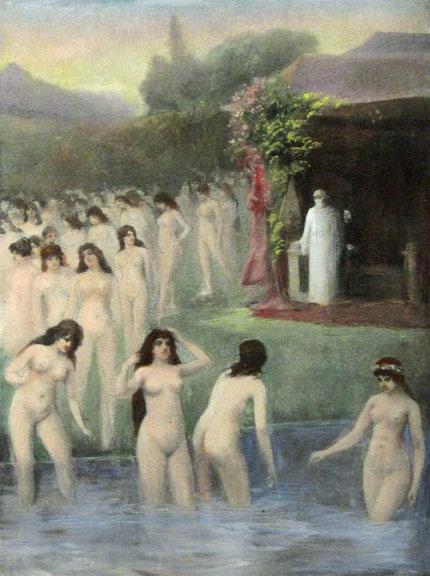
His Great Translation of the “Arabian Nights”
With a Double-Set of 142 of Letchford’s Plates - 1897
43 Burton, Richard F., [translator]. A PLAIN AND LITERAL TRANSLATION OF THE ARABIAN NIGHTS’ ENTERTAINMENTS, NOW ENTITLUED [sic] THE BOOK OF THE THOUSAND NIGHTS AND A NIGHT. With Introduction, Explanatory Notes on the Manners and Customs of Moslem Men and a Terminal Essay Upon the History of The Nights [with] SUPPLEMENTAL NIGHTS... With Notes Anthropological and Explanatory (London: H.S. Nichols, Ltd., 1897) 12 volumes. Rare and Most Probably a Unique Presentation of the Illustrated Library Edition. 142 original illustrations, including a portrait of Burton, reproduced from the original pictures in oils specially painted by Albert Letchford with one set of the original 71 illustrations presented as included by the publisher and another set individually hand-coloured. 8vo, splendid, handsome and very finely executed three-quarter gilt-bordered dark red morocco over vellum covered boards, the spine in compartments separated by wide gilt decorated raised bands, the compartments of the spine elaborately decorated and lettered in gilt with beautiful arabesque designs, t.e.g., marbled endpapers. A very handsome and unusually appealing set. The bindings are very stately and attractive and the colouring of the illustrations beautifully accomplished. We know of no other handcoloured copy being offered in recent
memory. Some old stains to the edges of some leaves or plates, lower corners of a few volumes with old evidence of damp. Spines, gilt-work, bands all in excellent condition..
A VERY RARE AND PROBABLY UNIQUE SET OF THIS HIGHLY IMPORTANT EDITION, THE FIRST TO BE ILLUSTRATED, AND THIS COPY WITH AN ADDED SET OF THE ORIGINAL PLATES SINGULARLY HANDCOLOURED. Nichols’ printing is a scarce and handsome edition, the first to include the illustrations by Letchford. In 1896, two years after their first edition of ARABIAN NIGHTS, the Nichols-Smithers duo commissioned Sir Richard Burton’s close friend, Albert Letchford, to paint 65 illustrations for another edition as well as a portrait of Burton, and soon after commissioned for 5 more. Burton and Letchford had met several years before when Letchford was 18 when he was in Florence beginning his art education and had discussed the possibility of illustrating “Nights.” “Burton’s suggestion of illustrating the “Nights” had appealed greatly to Letchford on account of the unlimited scope such a subject would give to an artist who loved the East and had a boundless imagination.” Letchford commenced study of Eastern images for his paintings, though only one of the illustrations was painted in Burton’s lifetime.
Burton’s “Nights” was enthusiastically received and lauded as “masterly, strong, vital, and picturesque,” and as “one of the most important translations to which a great English scholar has ever devoted himself.” However, it was not without its critics, including th Edinburgh Review which wrote, “Probably no European has ever gathered such an appalling collection of degrading customs and statistics of vice.”
$12,500.
An Extraordinary, Very Rare Milton Sammelband - 1688-1695
“Paradise Lost” and the Accompanying Poems Complete First Editions and the Collected Works - Rare Large Paper Copy
44 Milton, John. THE POETICAL WORKS OF MR. JOHN MILTON. Containing, PARADISE LOST, PARADISE REGAIN’D, SAMSON AGONISTES, and his POEMS ON SEVERAL OCCASIONS. Together With Explanatory NOTES ON ON EACH BOOK OF THE PARADISE LOST, and a TABLE never before Printed. (London: Printed for Jacob Tonson at the Judge’s-Head near the Inner-Temple-Gate... by Tho. Hodgkin et. al., 1695 [but 1688 and 1695]) Very Rare LARGE PAPER COPY of The First “Collected” Edition. A sammelband of the poems of Milton. This copy comprised of the sheets of the large paper 1688 printing of the first illustrated edition of PARADISE LOST. A POEM IN TWELVE BOOKS with a 1695 reissued title-page for this edition; PARADISE REGAIN’D. A POEM. IN IV BOOKS. To whiich is added SAMSON AGONISTES, A DRAMATICK POEM. [these with the 1688 Title-Pages included, Printed by R.E....MDLXXXVIII and for Randal Taylor....MDCLXXXVIII ] and with the large paper issuance of the first printing of the NOTES [by Patrick Hume]as well as the additional
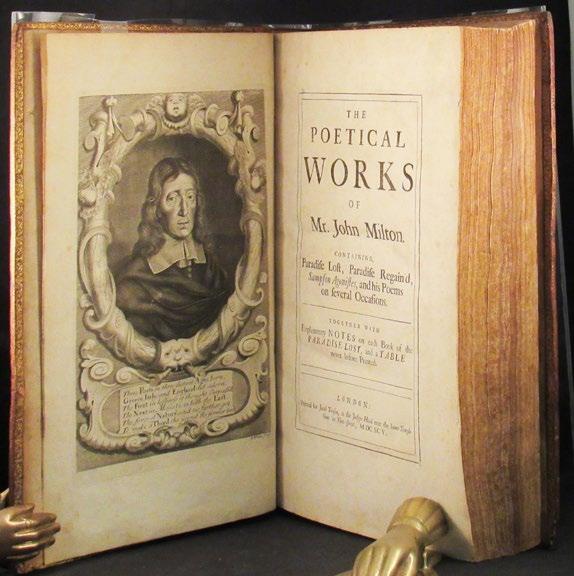
“POEMS”. Engraved portrait frontispiece and the 12 copperplate engravings by Burg after Medina used in the first illustrated edition of 1688. Folio, very fine full early calf Farquhar, the covers decorated with double gilt fillet and stippled lines and corner tools and elaborately tooled gilt turnovers, the spine sometime restored and very handsomely decorated incorporating fine tooling and strapwork in gilt and with a morocco lettering label gilt. (5ff.), 343, an original sheet listing some subscribers to the original 1688 edition, [3] the table, 321 [the notes], 66, 60. A fine, crisp and clean copy throughout, the binding in excellent condition, the refurbished spine panel beautifully restored expertly and sympathetically.
RARE LARGE PAPER COPY OF THIS EXCEEDINGLY IMPORTANT EDITION, THE FIRST OF THE COLLECTED WORKS WITH ORIGINAL 1688 LARGE PAPER SHEETS INCLUDED. Edward Hodnett considered this to be the “earliest serious effort to illustrate an important work of English poetry” (Five Centuries of English Book Illustration, 1988, p. 63), and the copperplate engravings have a dramatic power that was only matched 200 years later by John Martin.

We rarely encounter a collection of the three principal poems. This collection which includes the POEMS ON SEVERAL OCCASIONS and the NOTES ON MILTON’S PARADISE LOST, can be truly classified as the first collected edition and a wonderful sammelband preserved through time by highly appreciative collectors. Such collections are rare. This collected edition is augmented by the inclusion of the highly important NOTES ON MILTON’S PARADISE LOST, POEMS ON SEVERAL OCCASIONS and additional poems as well.
In PARADISE LOST, PARADISE REGAINED and SAMSON AGONISTES
Milton revived the heroic verse of Homer and Virgil to frame the tale of Satan and Paradise that has become the best-known epic poem written in English. He had difficulty in finding a publisher because of the plague of 1665, which killed many pressmen, and the Great Fire of the following year, which destroyed many printing houses—and those publishers who were still operating were wary of the project because of Milton’s anti-Restoration sympathies.
Simmons, to whom he finally came, drove a hard bargain, and according to the agreement reached and the number of copies sold Milton was paid a total of £15. Milton’s work survives and is revered to this day as amongst the most significant poetry and prose ever penned and additionally important, at a defining moment in the development of the English language. A truly towering figure, Milton remains one of the most celebrated and analyzed poets in English literature. Dryden described ‘Paradise Lost’ as ‘one of the greatest, most noble and sublime poems which either this age or nation has produced,’ while Blake, keying in on the poem’s heretical implications, described Milton as ‘a true Poet, and of the Devil’s party without knowing it.’
$22,500.
A Pioneering and Monumental Work - 1902-1930
Charles Oman’s Singular History of the Peninsular War With an Important Autograph Letter by the Author Over Four Thousand Pages of Academic Excellence
45 [Napoleonic Wars]; Oman, Charles. A HISTORY OF THE PENINSULAR WAR From the treaty of Fontaineblueau...[to] the Capture of St. Sebastian, Wellington’s Invasion of France, Battles of the Nivelle, the Nive, Orthez and Toulouse (Oxford: The Clarendon Press, 1902-1930) 7 volumes. First Edition. WITH AUTOGRAPH LETTER FROM THE AUTHOR. A two page manuscript letter signed by Charles Oman to “Dear Archdeacon” is laid into the book. We surmise that it is written to the Archdeacon of Oxford, who at the time was Edward Shaw. The letter is dated November 22, 1930, and has excellent content relating to the publication of volume VII of THE PENINSULAR WAR. The letter also makes mention of the first four volumes of Oman’s work and includes substantial content relevant to the work. The letter is written on two sides of a quarto size sheet of stationary stamped in blind “Frewin Hall, Oxford”. Illustrated throughout with plates, portraits, plans and an extensive number of maps, many of which are in colour and folding. Tall, thick 8vo, bound in the publisher’s original red cloth, the upper
covers with central gilt reproductions of related coins and seals, the spines gilt lettered. A very good and pleasing set, the text-blocks very clean with minimal light and scattered signs of age, the books with only minor and varied evidence of use, the bindings are sturdy with all hinges intact, one volume with minor wear to the cloth along its rear joint, each with some general mellowing and a bit of light fading to the spines.
EDITION WITH IMPORTANT AUTOGRAPH LETTER OF A MONUMENTAL
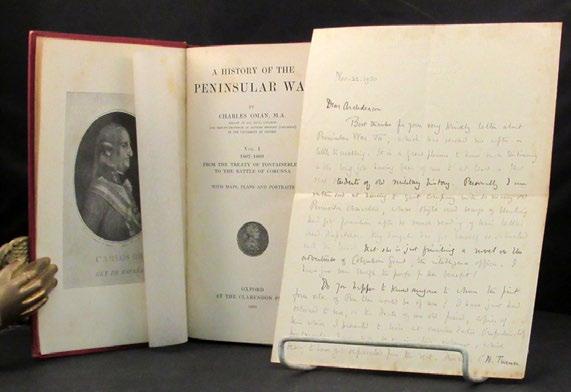
Among other activities at Oxford, Oman taught a special subject of military history with C.T. Atkinson of Exeter College that focused on the Peninsular War. His academic career, and the publication of these volumes, was interrupted by the First World War, during which he was employed by the government’s Press Bureau and the Foreign Office. The first five volumes were published prior to the Great War, the final two after.
This seven-volume history is appealing, scholarly, thorough, and definitively covers the Peninsular War (1807-1814) in the Iberian Peninsula during the Napoleonic Wars. Oman had access to “everything available” and then pursued more, discovering diaries, memoirs, military dispatches, general orders, “parliamentary papers”, filed newspapers, pertinent national archives, and so on. Oman is widely perceived as unbiased with his coverage. In fact, one of his main objectives for writing this history was to counter Sir William Napier’s seemingly flawed recounting of events in Napier’s own six volume work.
Producing this seven volume history took 30 years and demonstrates Oman’s unflagging “industry, perseverance, and volume of reading.” Only one of his interpretations from this work has been significantly challenged--that British troops defeated their Napoleonic opponents by firepower alone. Later historians tend to believe that strategy, discipline, and motivation were equally important. Robinson, R.E.R. “Review Article”. Journal of the Society for Army Historical Research; Stevens, Wayne The Journal of Modern History; Journal of the Society for Army Historical Research. $5500.
From the Beginning of 1684 - Very Rare and Very Beautiful
Japan Eiri Edo Oezu - Very Large Joined and Folded Paper
46 [Japanese Hand-Coloured Wood-Block Printing]; [Maps and Atlases]; [Tokyo Map], Hyoshiya Ichirobe. A WOODBLOCK HAND-COLOURED MAP OF TOKYO; JAPAN EIRI EDO OEZU (Illustrated Edo) (Edo [Tokyo]: Hyoshiya Ichirobe (Hayashi-shi Yoshinaga), First month, 1684 (But Third month, 1680)) A large woodcut map of Edo (Tokyo) with fine handcolouring, on joined and folded paper. The map is breathtaking in its detail and features many paintings of important landmarks, temples, bridges and people, who are often pictured working or fishing from boats on the waterways running through Tokyo. A stunning and very rare woodblock map beautifully and unusually handcoloured. Roads, blocks, buildings, open areas, canals and waterways, are all vividly laid out on this huge and most impressive map. 123.5 by 149.5 cm., folded within paper covers, folds to 28 by 18 cm, now preserved in a fine clamshell box. A remarkably well preserved and very rare item, with some light rubbing due to age and as to be expected. A bit of old worming or light soiling and occasional small repairs,
but in all quite astonishing in its quality and beautifully preserved with bright and vivid colour and detail.
AN EXTRAORDINARY ITEM, REMARKABLE FOR BOTH ITS CARTOGRAPHIC DETAIL AND ITS ARTISTIC BEAUTY. The wood block printing shows land tenures of Daimyo and Hatamoto. It also shows temples and shrines, includes a distance chart and descriptive listing of Daimyo showing crests and halberds. There is also a inset of the eastern portion of Edo. East Asian Library, Berkeley EA9. $17,500.
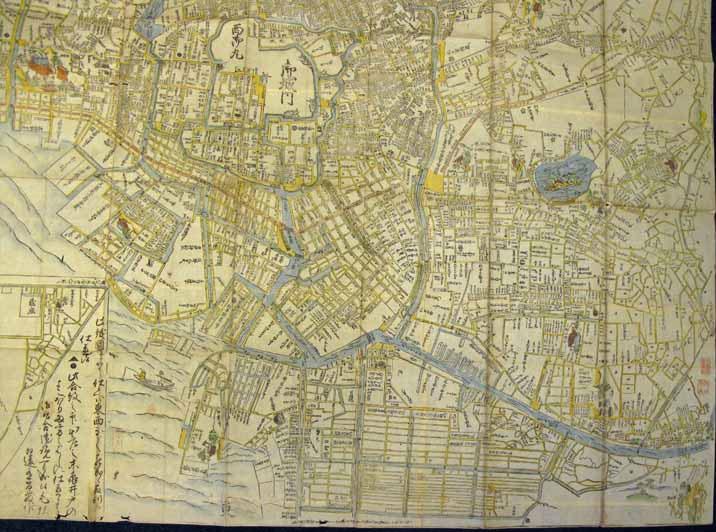
Perhaps the Most Rare and Beautiful Gustave Doré of All Corrida de Toros - Paris - L. Turgis - Circa 1860 Exquisitely Coloured and a Highly Unusual Offering
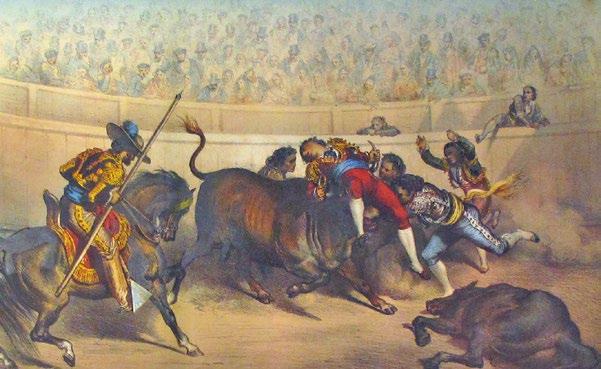
47 Doré, Gustave. CORRIDA DE TOROS (Paris: L. Turgis, ca. 1860) EXTREMELY RARE SUITE OF HANDCOLOURED LITHOGRAPHS ON BULLFIGHTING. A complete suite of six large hand-coloured original lithographs by Gustave Doré. 45.5 by 61.4 cm, Each plate with the running title ‘Corrida de Toros’, individual captions in Spanish and French and with ‘G. Doré del. A fine set with occasional evidence of age.
FIRST ISSUE AND VERY RARE, A SUITE OF IMAGES ON BULL FIGHTING AS SEEN AND CHRONICLED BY GUSTAVE DORÉ. In Corrida de Toros, Doré captured the strength and movement of the bull, the tension, the danger in the ring - it almost seems as if the bull has a chance, not just at survival but of actually conquering the men on foot and horseback who are supremely annoying it to rage. Doré appears to sympathize with the bull and the tragedy of bullfighting rather than the glory of the fighters.
‘The French artist, Gustave Doré, was born in Strassburg in 1832. In 1848, he moved to Paris where it was noted that “his facility as a draughtsman was extraordinary.” He was a prolific worker whose talents and creations are greatly valued to the present day. Doré’s first illustrated story was published when he
was only fifteen years old. His talent was evident even earlier, however. At age five he had been a prodigy troublemaker, playing pranks that were mature beyond his years. Seven years later, he began carving in cement. Subsequently, as a young man, he began work as a literary illustrator in Paris, winning commissions to depict scenes from books by Rabelais, Balzac, Milton and Dante.
In 1853, Doré was asked to illustrate the works of Lord Byron. This commission was followed by additional work for British publishers, including a new illustrated English Bible. A decade later, he illustrated a French edition of Cervantes’s Don Quixote, and his depictions of the knight and his squire, Sancho Panza, have become so famous that they have influenced subsequent readers, artists, and stage and film directors’ ideas of the physical “look” of the two characters. Doré also illustrated an oversized edition of Edgar Allan Poe’s “The Raven”, an endeavor that earned him 30,000 francs from publisher Harper & Brothers in 1883.
Doré’s English Bible (1866) was a great success, and in 1867 Doré had a major exhibition of his work in London. This exhibition led to the foundation of the Doré Gallery in Covelant Bond Street. After an illness, he died in January of 1883. $28,500.
Mercer’s Journal of the Waterloo Campaign - First Edition

48 [Waterloo; Napoleon]; Mercer, General [Alexander] Cavalié. JOURNAL OF THE WATERLOO CAMPAIGN Kept Throughout The Campaign of 1815 (Edinburgh and London: William Blackwood and Sons, 1870) 2 volumes. RARE FIRST EDITION IN PRESENTATION BINDING. A UNIQUE COPY. A family presentation copy, inscribed to George E. Mercer from I. Tod-Mercer and dated [18]96. 8vo, in a beautiful Zaehnsdorf signed binding dated 1896, thus no doubt custom made for the presentation to George E. Mercer. The binding is of full crushed scarlet morocco richly adorned in fine late-Victorian style. The boards feature a wide frame of gilt vines, flowers and thistles which is further ruled in gilt then further surrounded by minutely detailed gilt rolling, the upper boards also lettered “Mercer’s Waterloo” in fine gilt stamping, the smooth rounded spines with gilt lettering with a gilt oval surrounded by more gilt vines and flowers which then grow both up and below to fully frame the spine panel, board edges gilt ruled, wide turn-ins gilt tooled in the same motif as the covers, silk endpapers with powder blue moire pattern and further gilt tooling complete this beautiful presentation, a.e.g. xii, 369; viii, 347 pp. An extraordinary set, the condition remains outstanding. The textblock is essentially pristine, the fine bindings show only the most minimal evidence of age. Truly and outstanding and unique copy.
A SCARCE AND IMPORTANT FIRST EDITION, SCARCE IN ANY STATE AND THIS AN EXTRAORDINARY COPY. Mercer’s ‘Journal’ is an important source for historians of the Waterloo campaign, as well as a detailed description of the landscape and people of Belgium and France in the early 19th century. It is one of the few accounts of the period written by an artillery officer. Mercer’s journals were kept throughout the campaign of 1815 but were not published until 1870, after his death. The work was compiled and written in its finished form some 30 years earlier, from the original notes Mercer wrote contemporaneously, with additions and verifications from correspondence and other sources. It covers the period from April 1815 to January 1816. Although he eventually rose to the rank of general, his fame is as commander of the British G Troop Royal Horse Artillery in the thick of the fighting at the Battle of Waterloo. It is also notable for its lengthy descriptions of the countryside and its people.
In spite of his position with the British Army, the work is usually found in 20th Century editions in French. Its historical value in the English-speaking nations was largely overlooked till its rediscovery with a Praeger edition in 1970. $2850.
Look For Volume Three of Our Fine and Rare Books Catalogue, Coming Soon!
Select Index of authors, printers, illustrators, and subjects
Ackermann, Rudolph 99
Africa 30, 33, 35, 36, 37, 40, 94
American Revolution 120
Arabia 125, 129, 135
Art Deco 110
Asia 37
Audubon, John James 88
Bacon, Sir Francis 4
Bardi, Giovanni 27
Barth, Henry 33
Bartlett, William 100
Batty, Elizabeth Francis 103
Bede, The Venerable 3
Bernacchi, L.C. 38
Bible 18, 63, 102
Birds 88, 96
Boccaccio, Giovanni 100
Bonaparte, Prince Charles Lucien 96
Boswell, James 75
Browning, Elizabeth Barrett 42
Buckingham, J. S. 111
Burne-Jones, Sir Edward 19
Burn, Robert. 101
Burton, Richard F. 34, 35
Byron, [George Gordon] Lord 43
Caesar, Caius Julius 22
Calcio 27
California 115
Camden, William 35
Carlyle, Thomas 45
Carroll, Lewis 45
Catlin, George 112
Cervantes, Miguel de 76
Chap Book 136
Charles Oman 71
Chaucer, Geoffrey 19
Cherry-Garrard, Apsley 38
Christmas 140, 141
Church, Frederick S. 139
Churchill, Sir Winston 122, 123, 124
Civil War 112, 113
Cooper, James Fenimore 52
Cowles, Captain Calvin D. 112
Custer, Elizabeth B. 113
Custer, George Genera 113
Daguerréotype 88
Dante Alighieri 76
Dapper, Olfert 36
Darwin, Charles 89, 90, 91, 92
Dickens, Charles 46, 68, 77, 137, 141
Dictionary 78
Domenech, Abbé Emmanuel 124
Doré, Gustave 66, 73, 102
Doughty, Charles M. 125
Dow, George Francis 119
Dulac, Edmund 137
Eliot, George 47
Erasmus, Desiderius 78
Ethiopia 23
Evelyn, John 69
Fielding, Henry 32, 48, 126
Fields, James T. 68
Fitzgerald, F. Scott 53
Football 27
Francis, [David]. 140
French and Indian War 117
French, Frank 136
Frost, Robert. 53
Galilei, Galileo 92
Gaudin, M. A. 88
German Children’s Tales 138
Gibbon, Edward 20, 127
Great Britain/England 35
Gutenberg, Johann 63
Hamilton, Alexander 114
Hamilton, Sir Ian 128
Hardy, Thomas 49
Harris, Captain W. Cornwallis 94
Harris, Joel Chandler 139
Hawks, Francis L. 117
Hawthorne, Nathaniel 54, 55
Hemingway, Ernest 56, 57
Hobbes, Thomas 5, 7
Holland, Philemon 95
Holy Land 108
Housman, Laurence 137
Hume, David 16 Incas 41
Irving, Washington 140, 142
Italy 103, 133
James, George Wharton 115
James Hall. 116
Japanese Map 72
Jarvis, Charles 76
Jesuit Missions 23, 37
Johnson, Samuel 75, 78
Josephus 80
Joyce, James 31, 50
Kelmscott Press 19
Kesler, Nicholas 22
Koberger, Anton 18
La Fontaine, Jean de. 102
Laurence 137
Lawrence, T. E. 128, 129, 131
Leslie, Miss Eliza 139
[Livy] T. Livius, of Padua 26
Locke, John 8, 9, 10
Lombardus, Petrus 22
Longfellow, Henry Wadsworth 57
Lucien-Graux, Docteur 110
Margaret E. Sangster 136
Marine Research Society 118
Matthews, Frederick C. 118, 119
Maugham, W. Somerset 104
Maxwell, Marius. 94
McKenney, Thomas L. 116
Mercer, General 74
Meyer, Hans 30
Meyrick, Samuel Rush 104
Mill, John Stuart 16
Milton, John 70, 81
Monstrelet, Enguerrand De. 67
Morden, Robert 35
Morris, William 19
Moser, James H. 139
Munroe, Edmond 140
Napier, Lt. Colonel W. F. P. 132
North American Indians 112, 116
Nugent, Thomas 133
Ovid 82
Palladio, Andrea 105, 106, 107
Parkman, Francis. 117
Park, Mungo 37
Peninsular War 71, 132
Perry, Commodore M. C. 117
Peru 41
Phelps, Ansel 136
Photography 88
Plato 28
[Pliny] Plinius Secundus 95
Purgold, Jean-Georges 43
Rackham, Arthur 140, 141, 142
Raleigh, Sir Walter 24, 84
Remington, Frederic 142
Roberts, David 108
Roddenberry, Gene 65
Roman Empire 20, 22, 26, 101, 127, 134
Rowling, J.K. 143
Ruskin, John 109
Russo-Japanese War 128
Sangster, Margaret E. 136
Schmied, François-Louis 110
Shackleton, E.H 38
Shakespeare, William 17, 27
Ships; Maritime 118
Ships; Naval 119
Sloan, John 104
Smith, Adam 11, 13, 14, 15
South Polar 38
Spain 126
Spinoza, Baruch De 85
Stanley, Henry M. 40
Star Trek 65
Steinbeck, John 58
Tacitus, Cornelius 134
Tarleton, Lieutenant-Colonel 120
Television Industry 65
Tenniel, John 45
Thomas, Bertram 135
Thucydides 6
Tolstoi, Leo. 86
Trollope, Anthony 51
Twain, Mark 59, 60
Vega, Garcilasso de la 41
Warhol, Andy 143
Waterloo Campaign 74
Westall, Richard 81
Westminster Abbey 99
Whaling, Ships, Sea 135
Whitman, Walt 60, 61
Wilson, Alexander 96
Winterbotham, W[illiam] 121